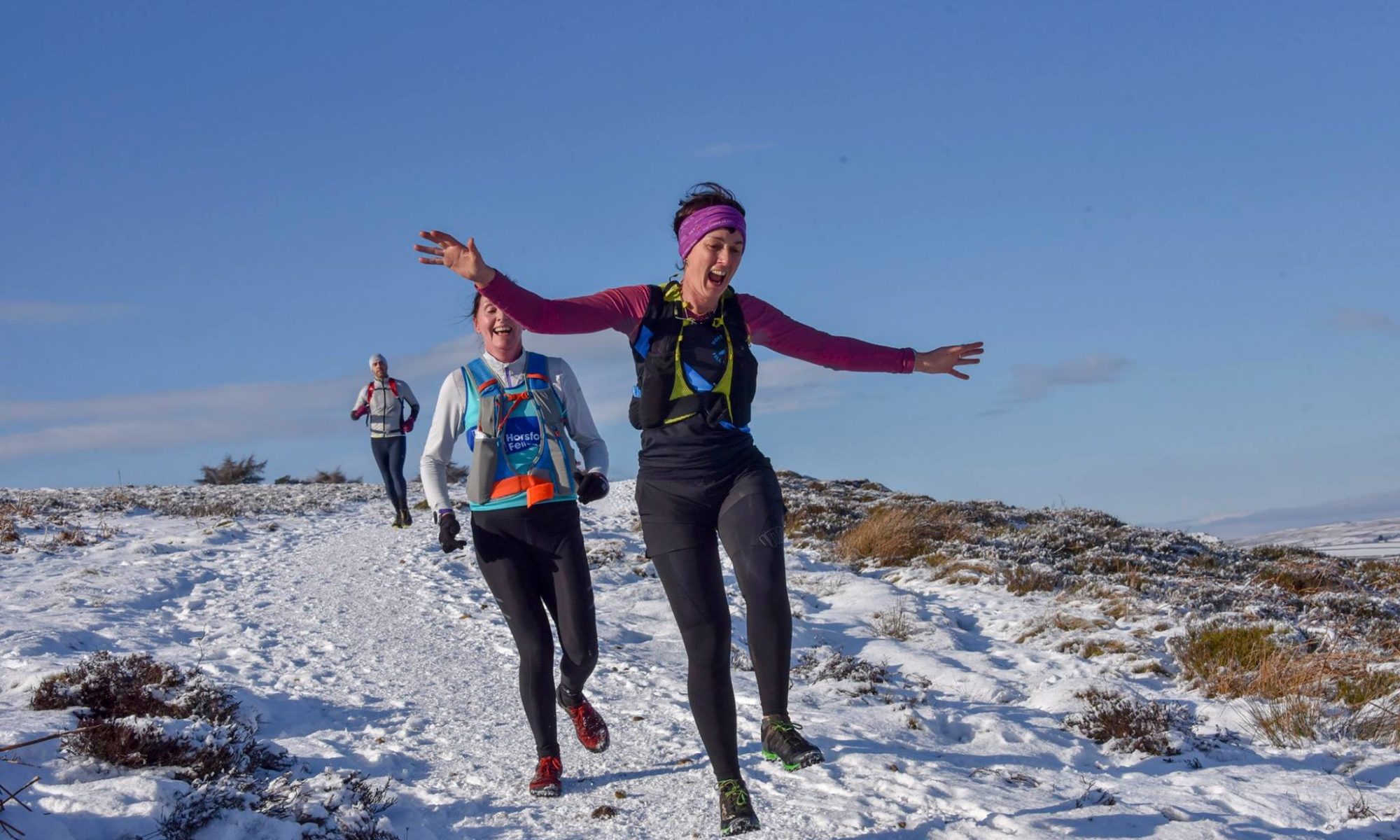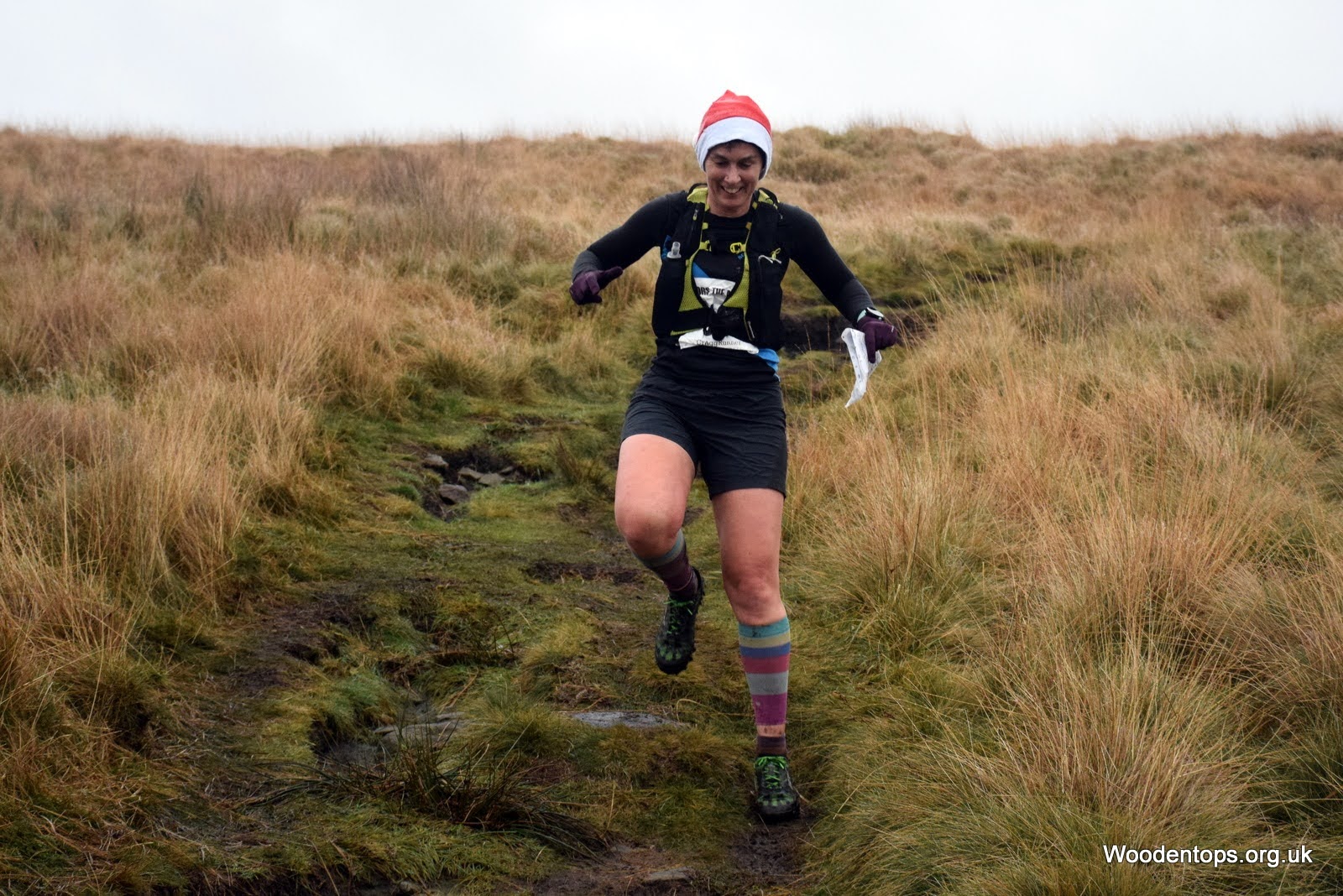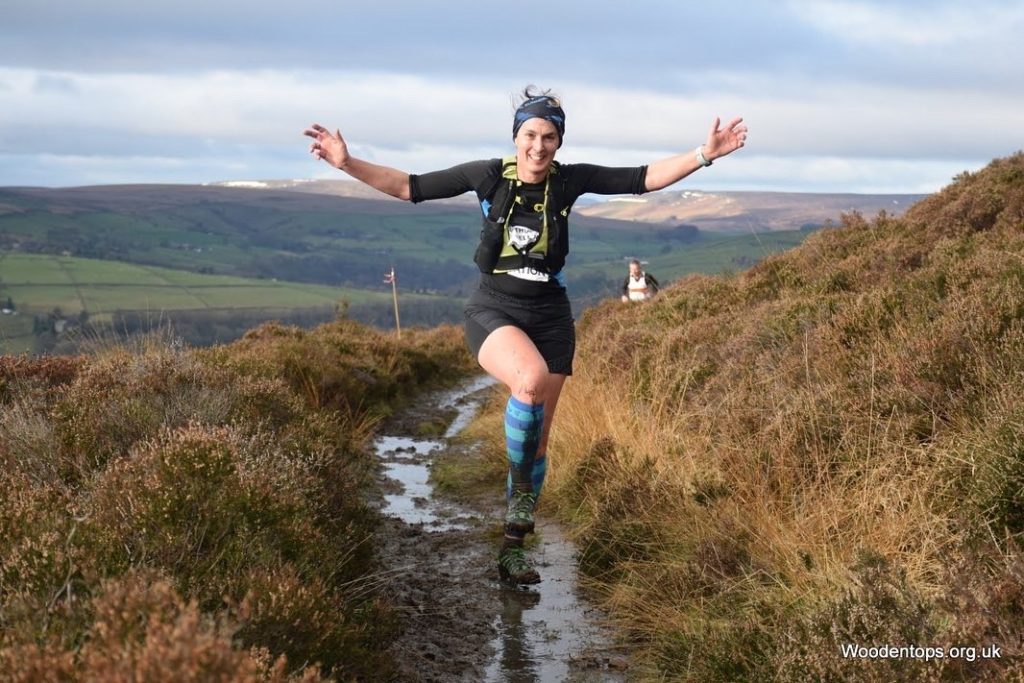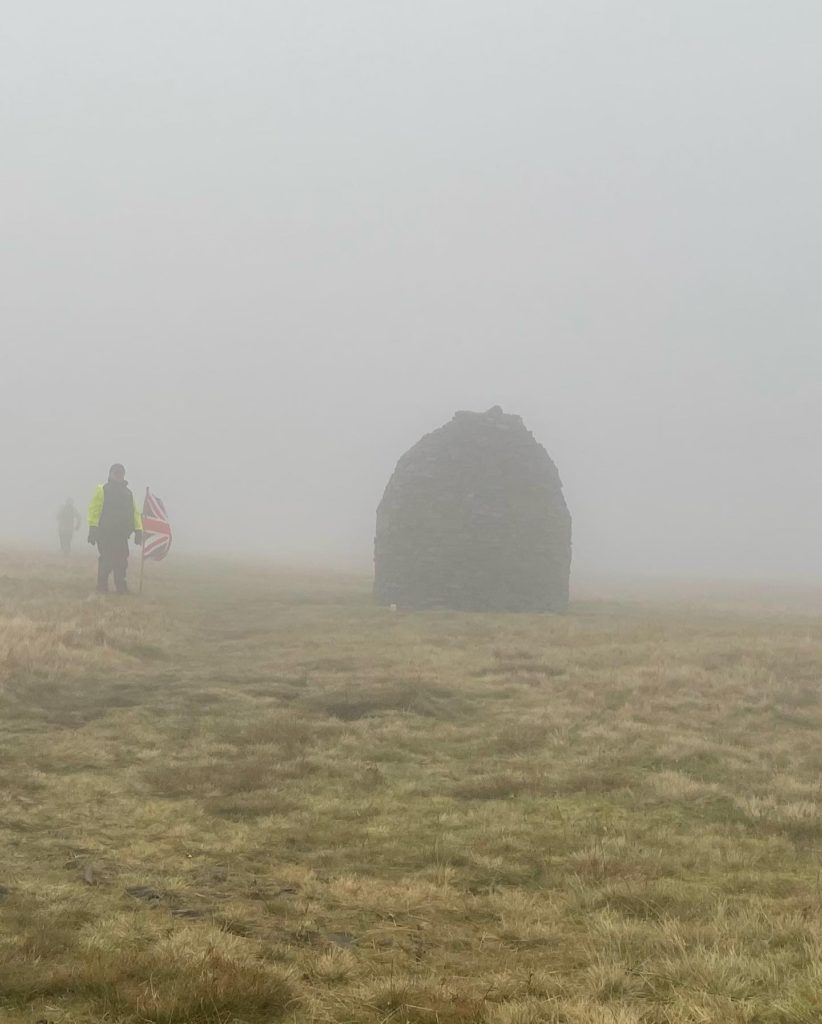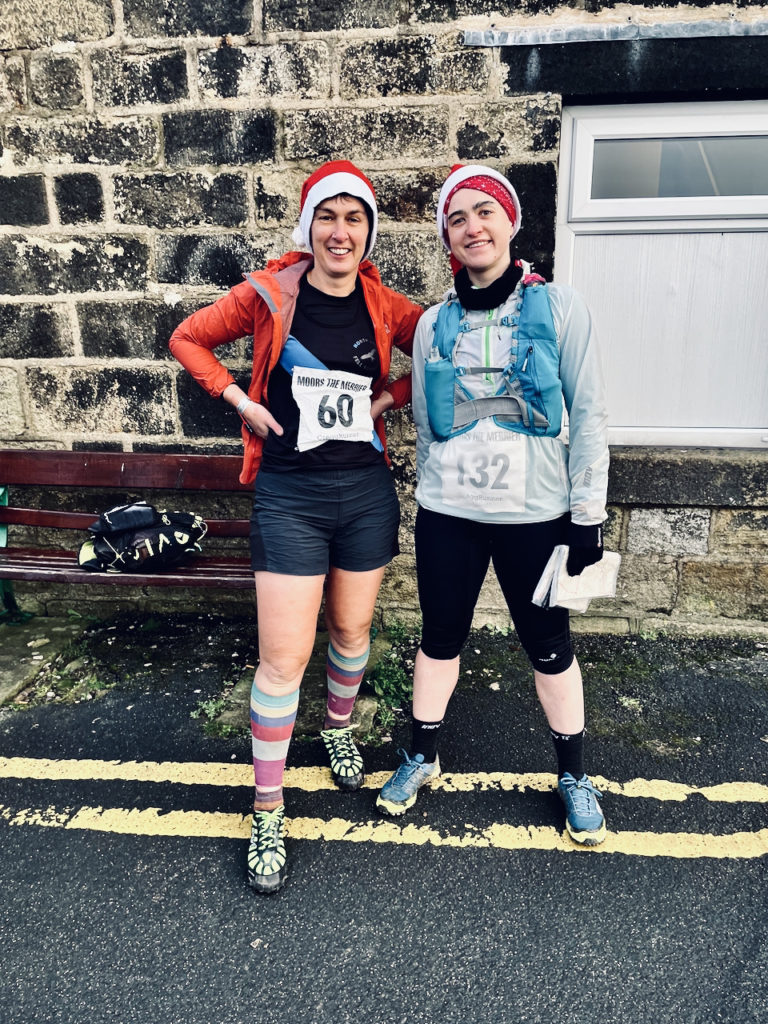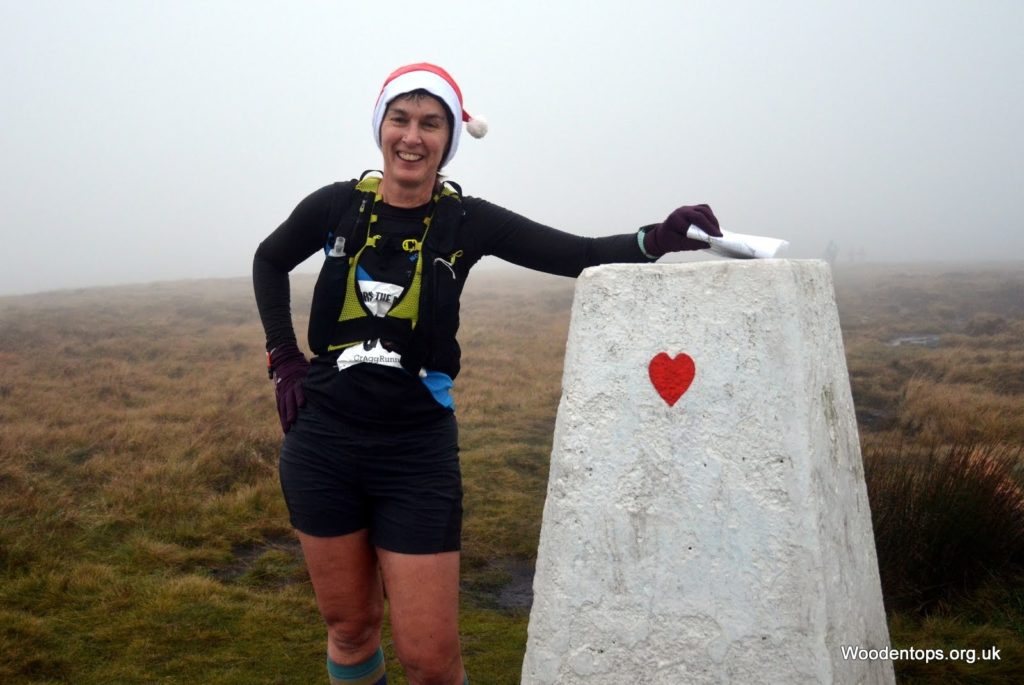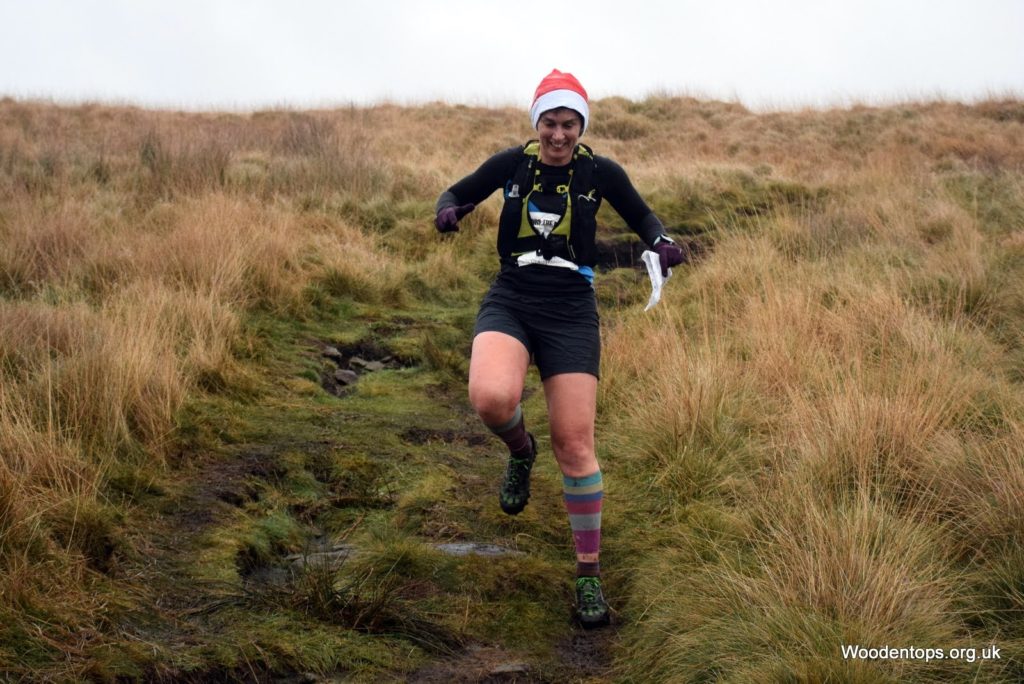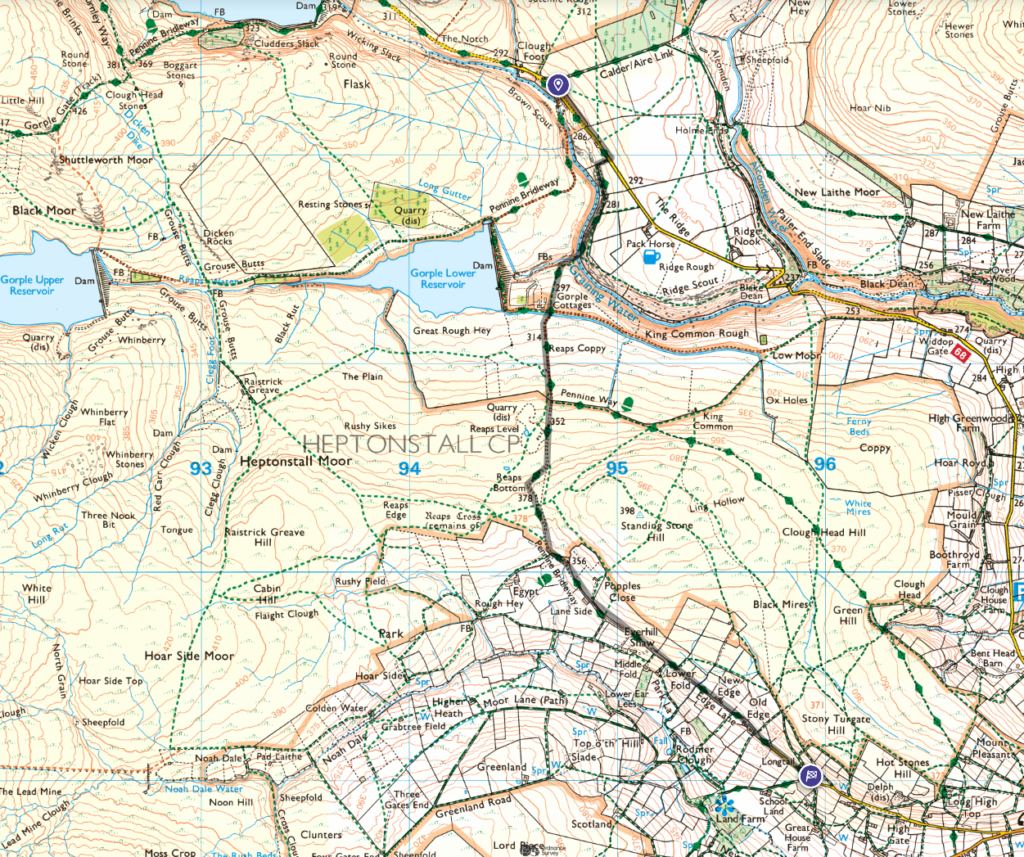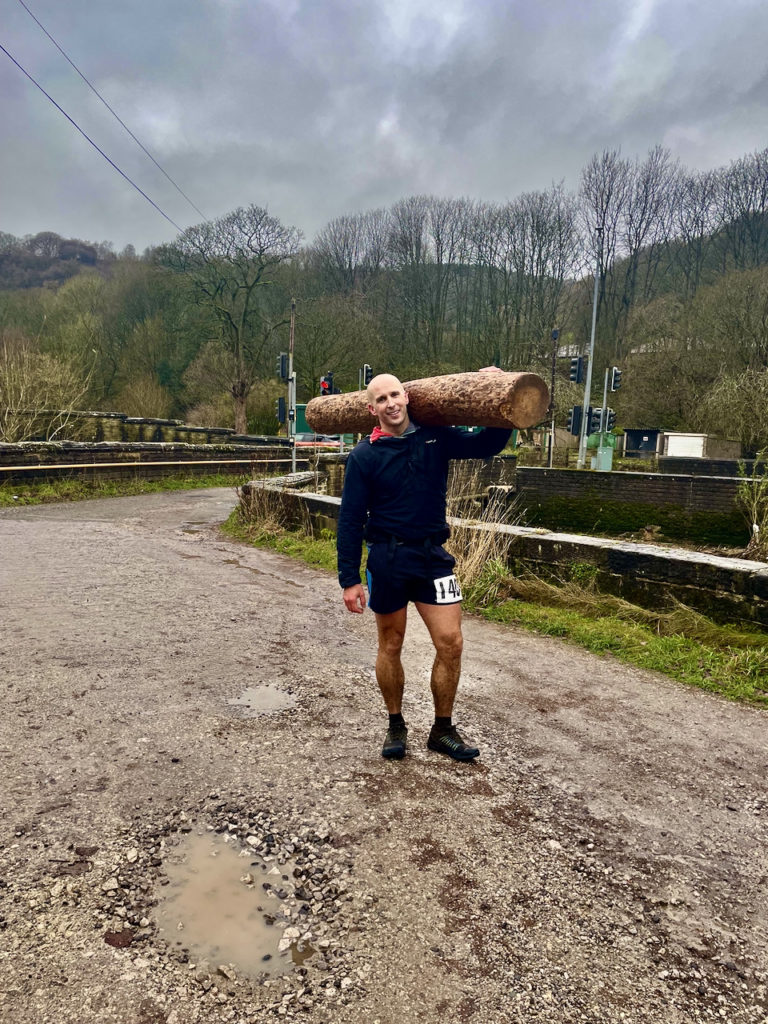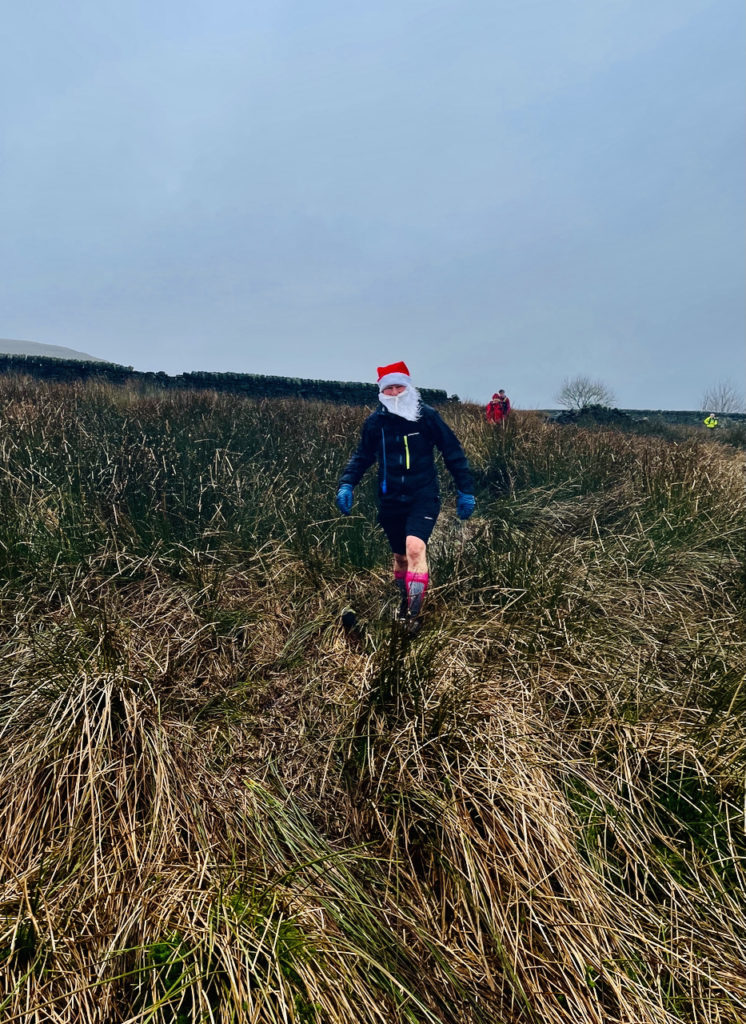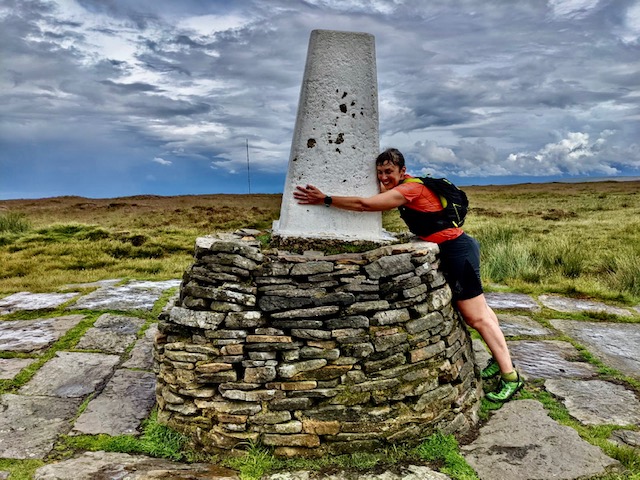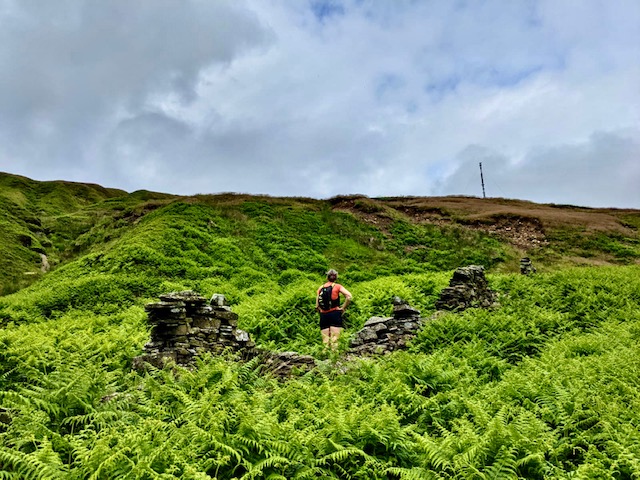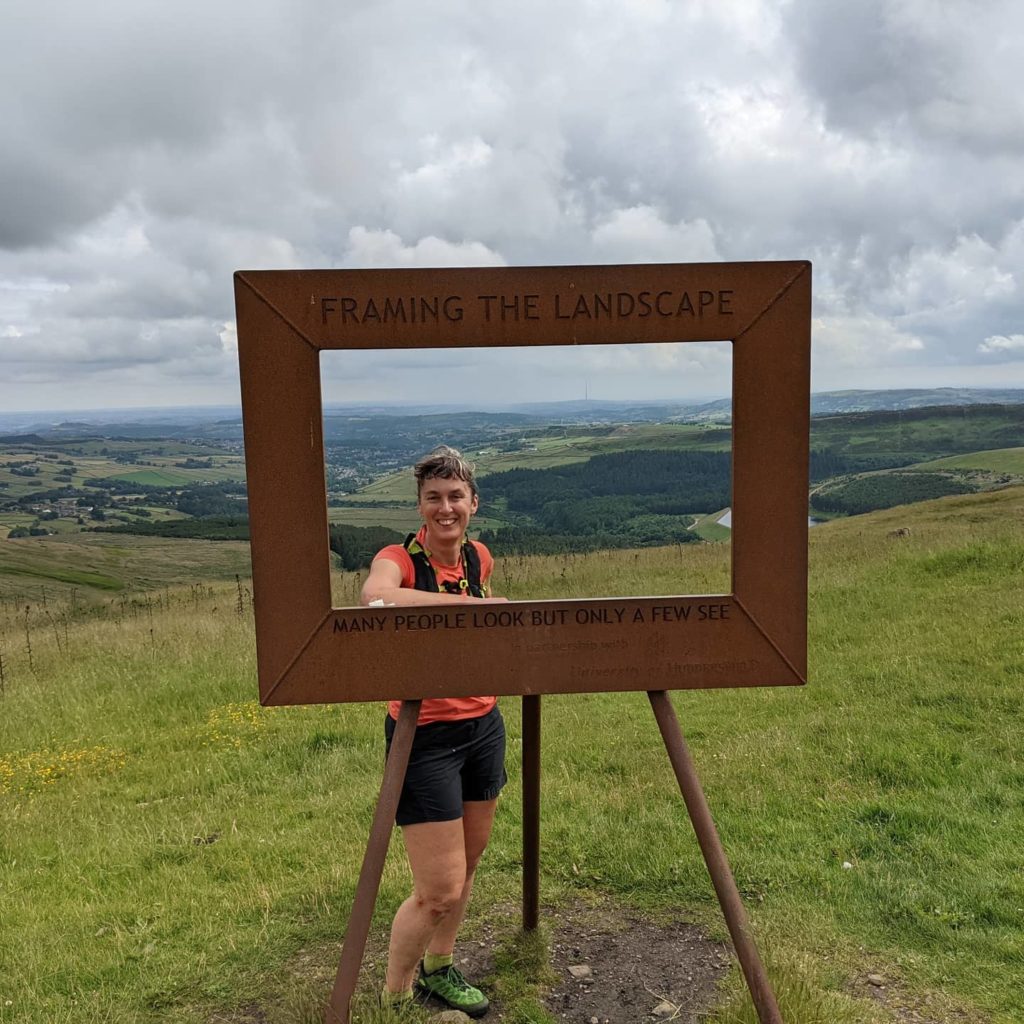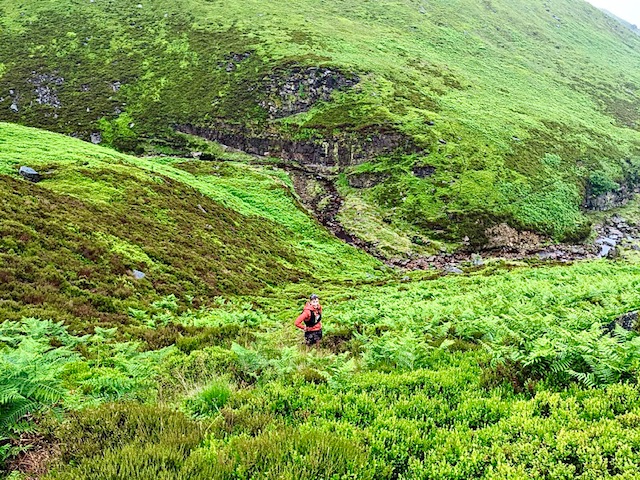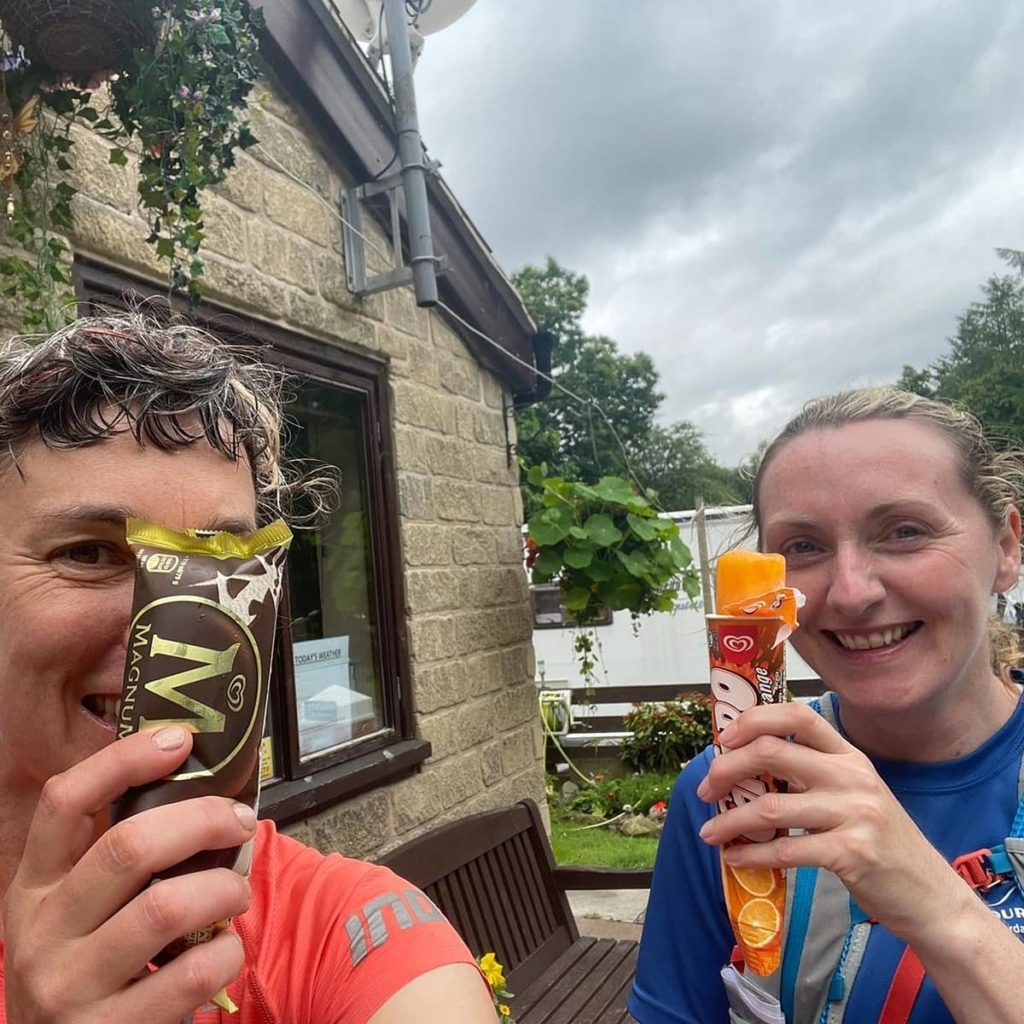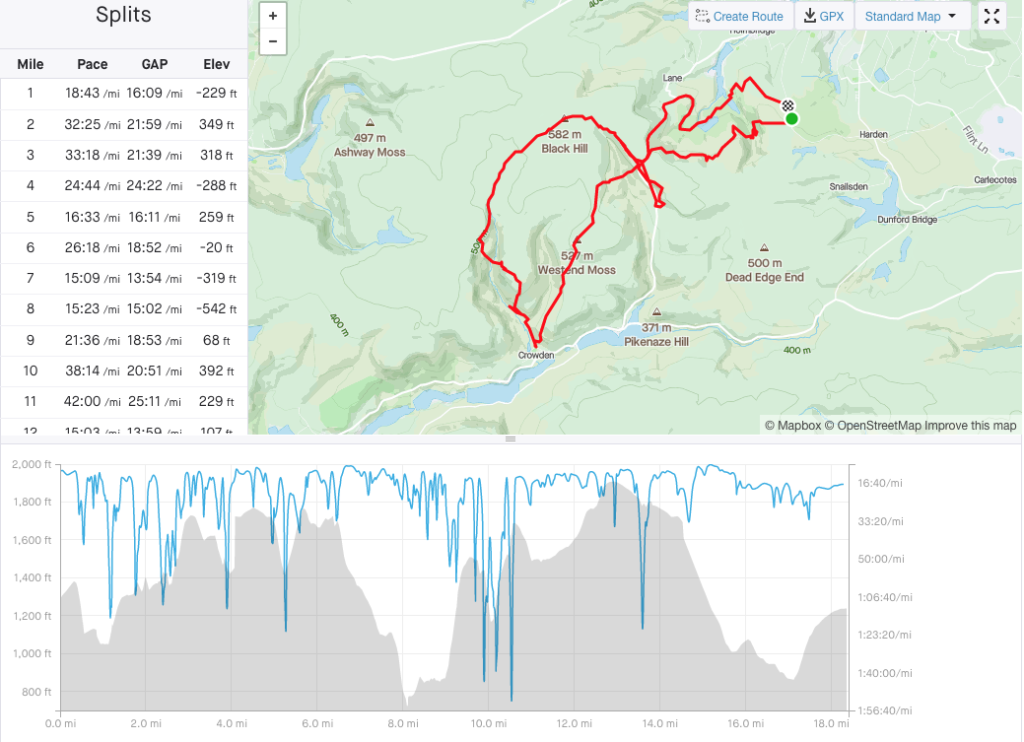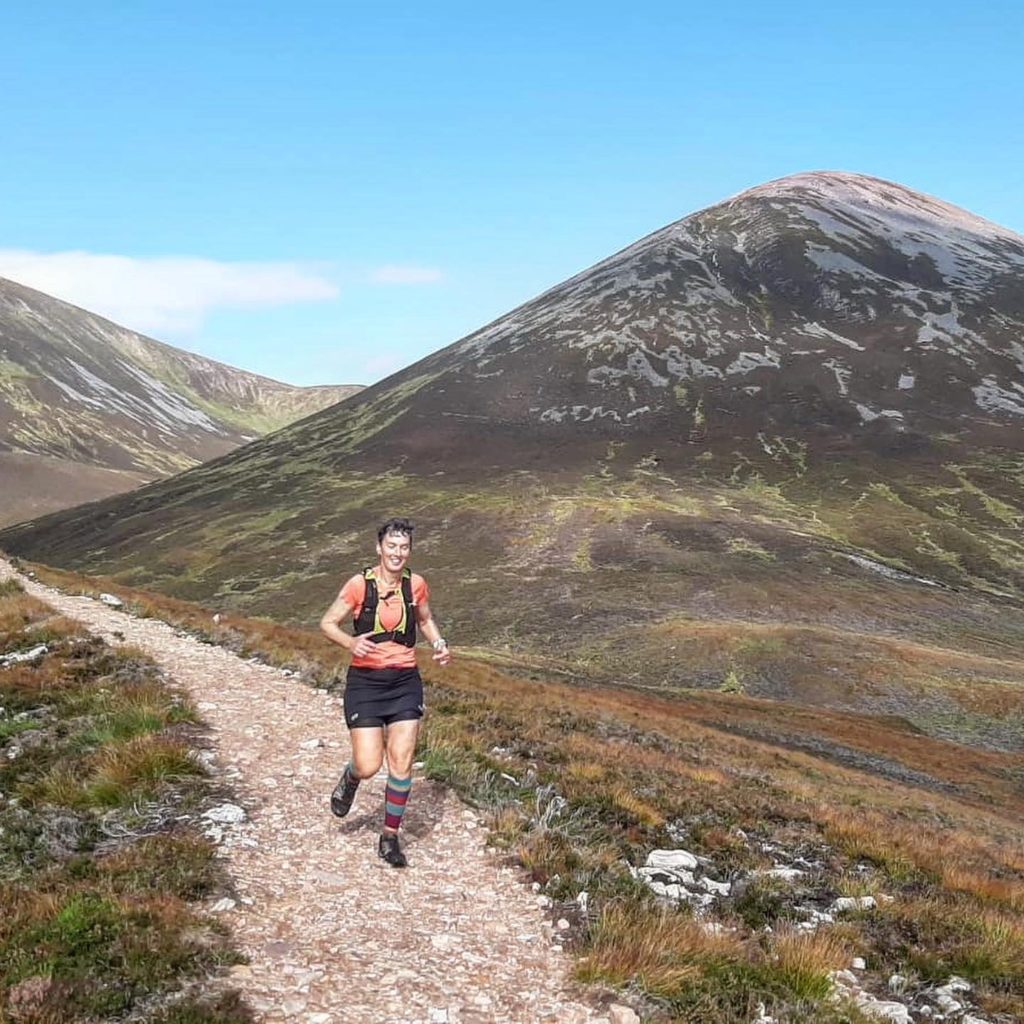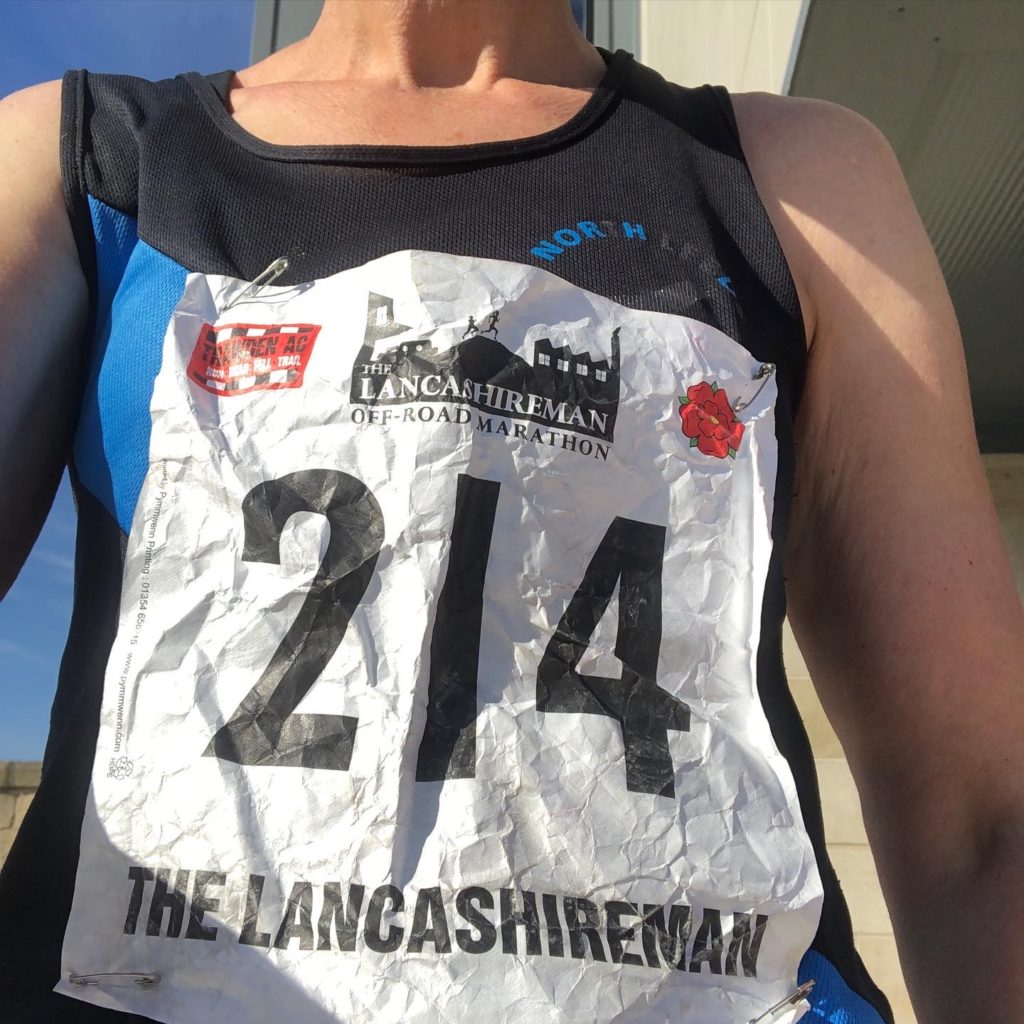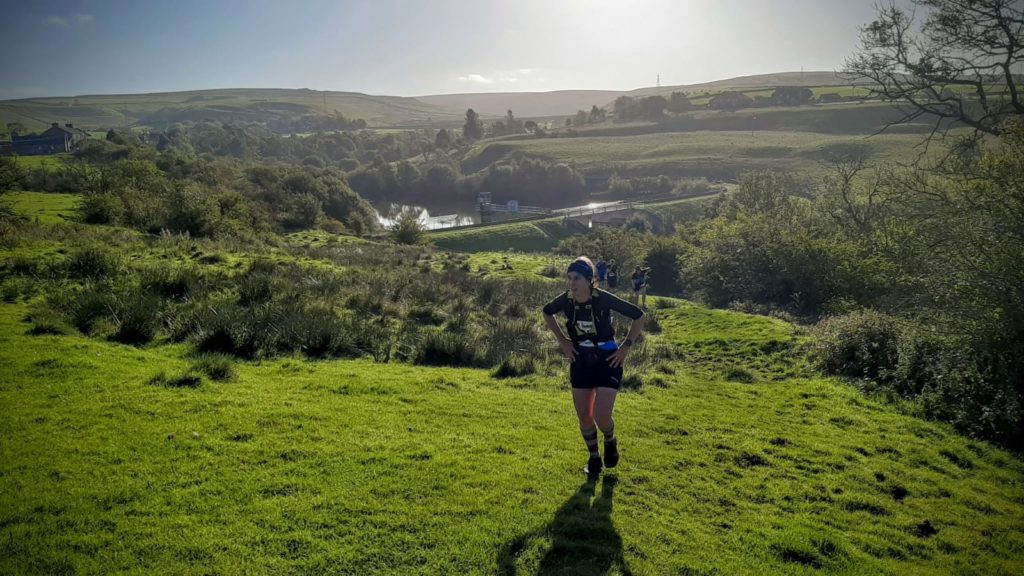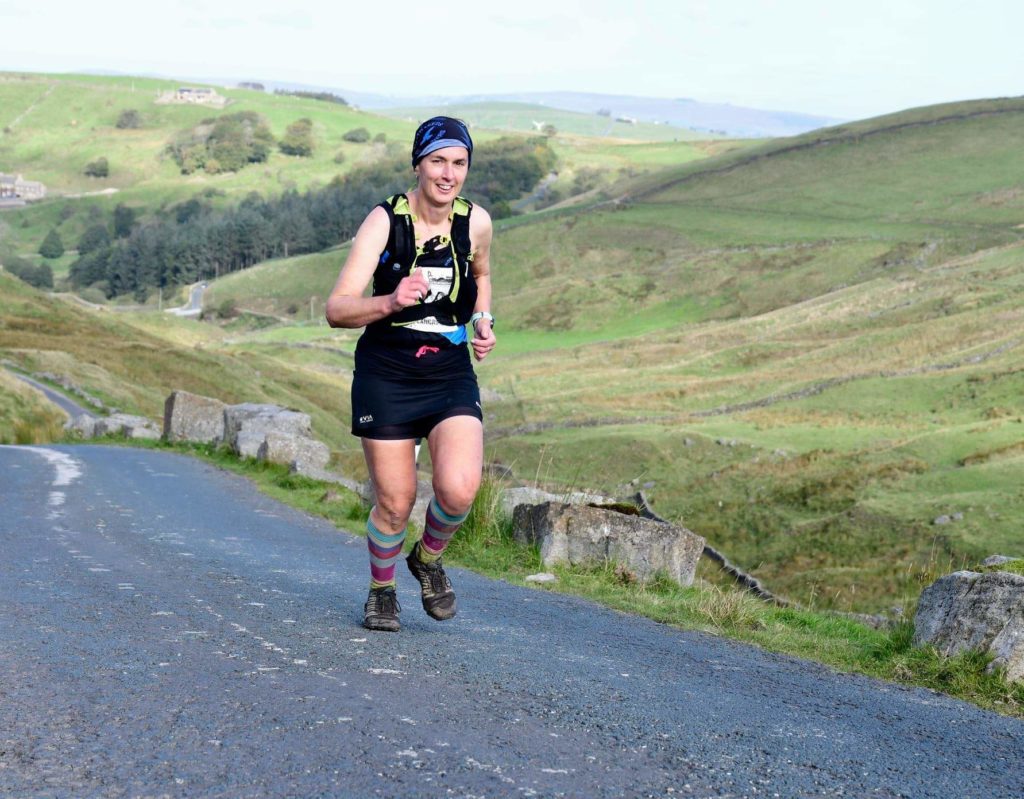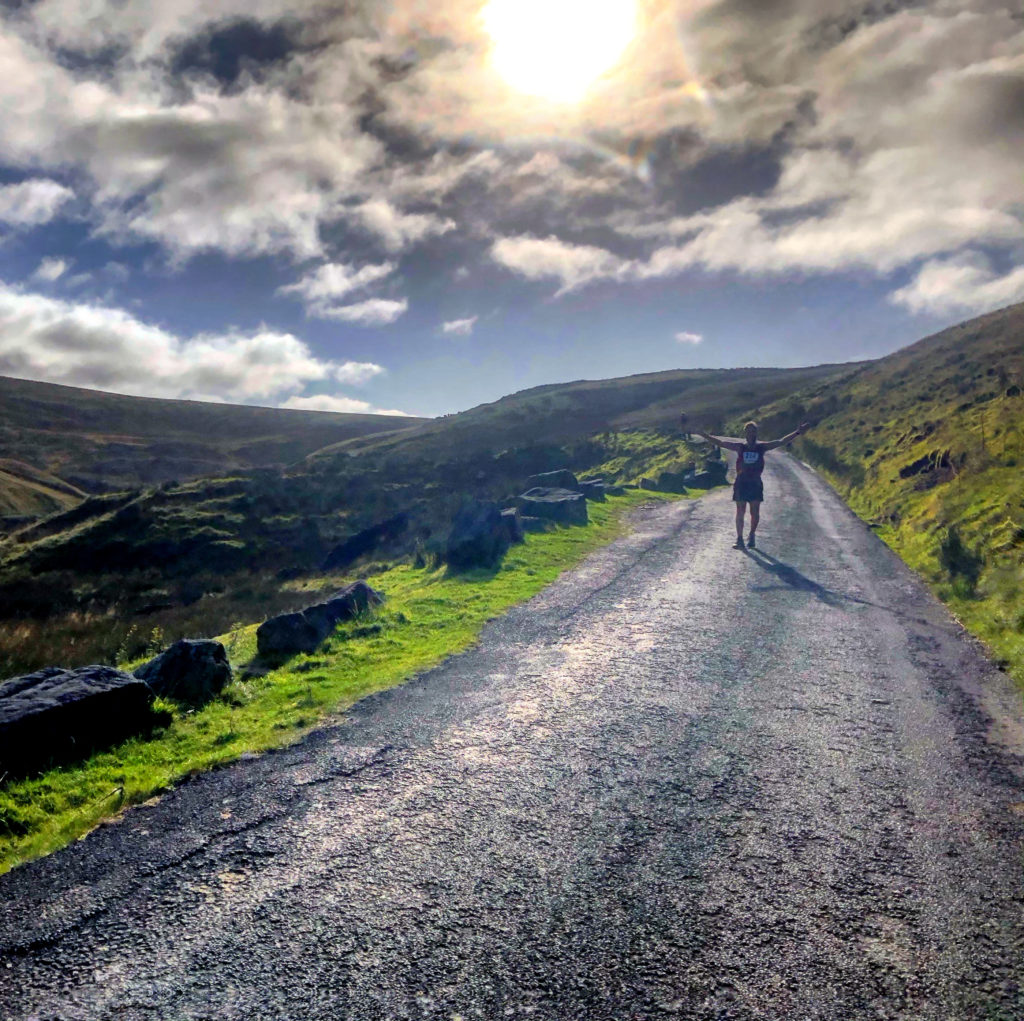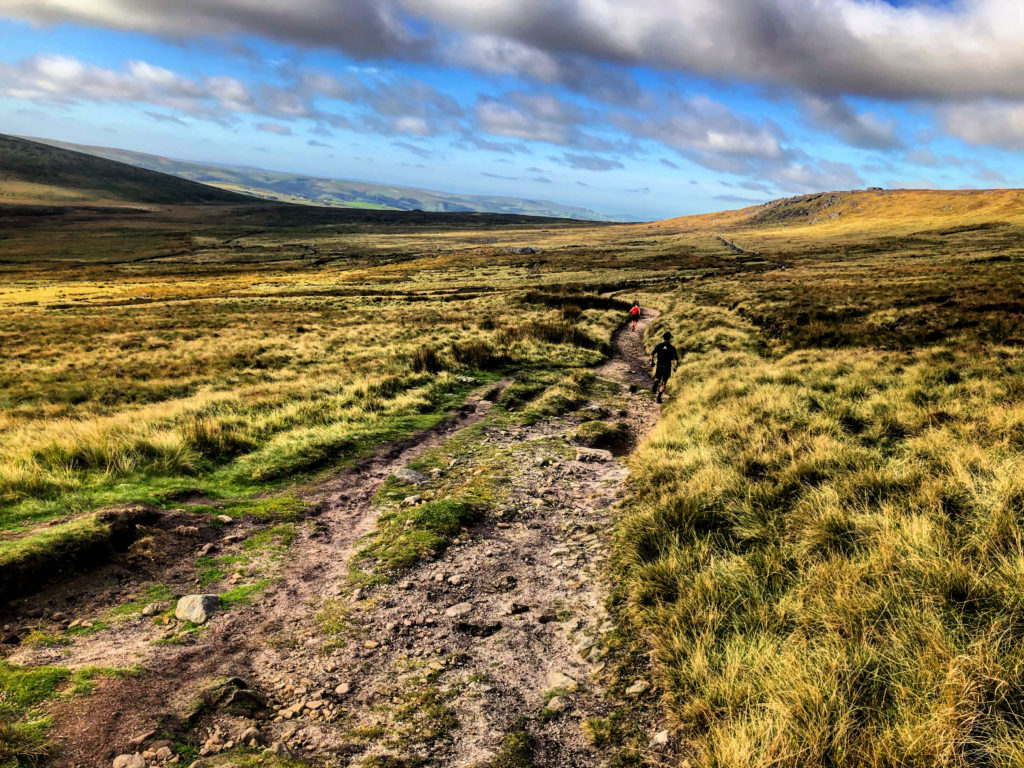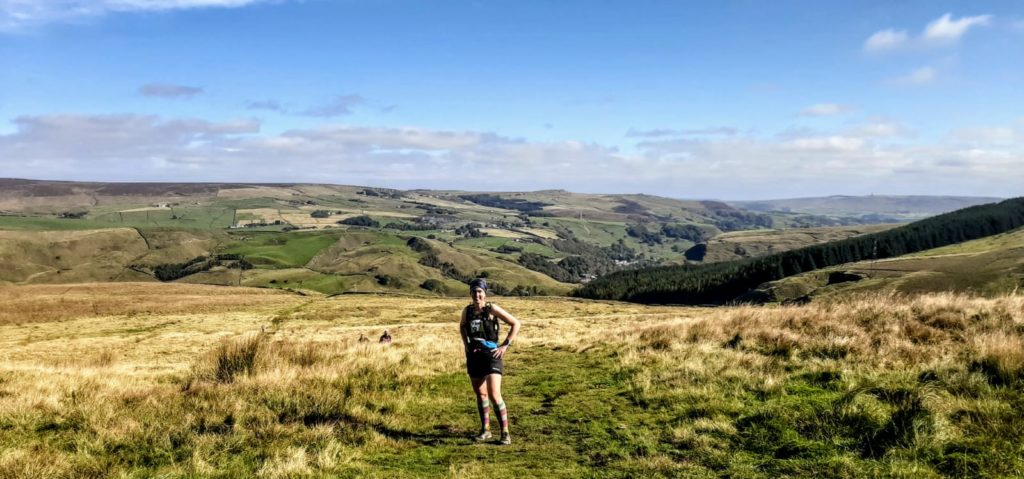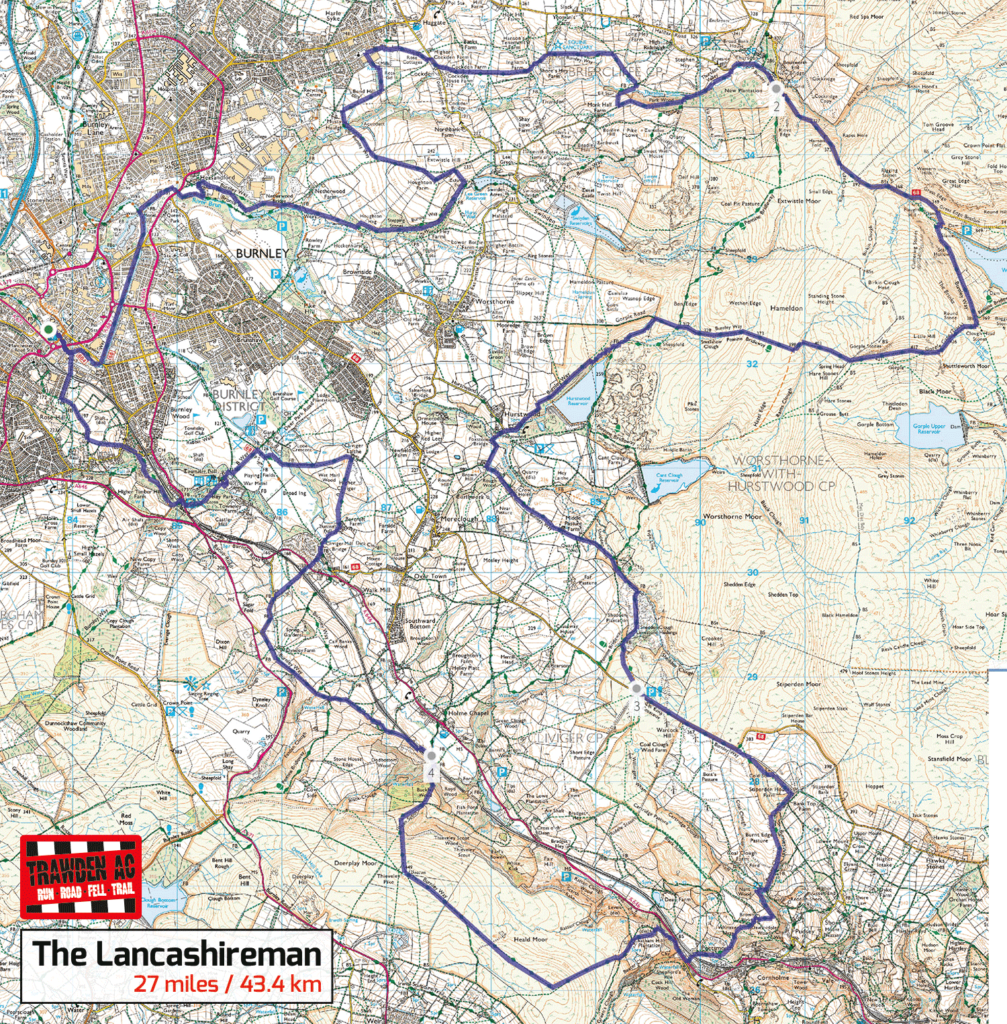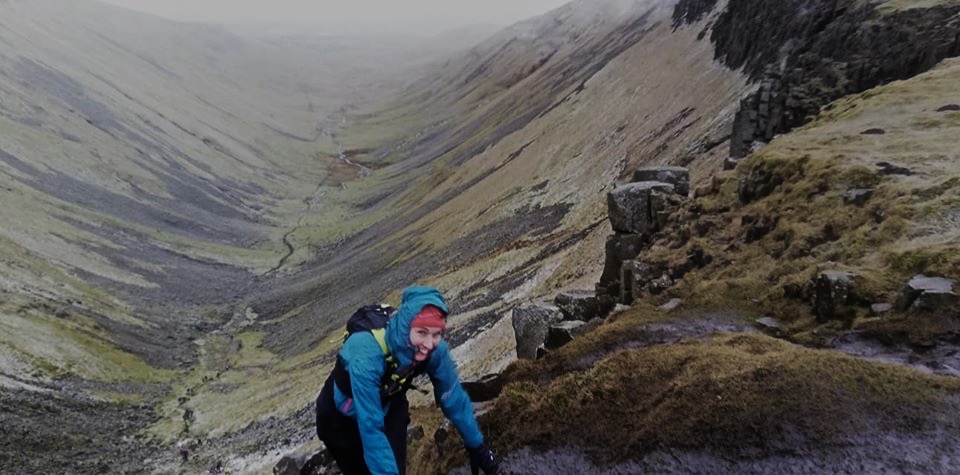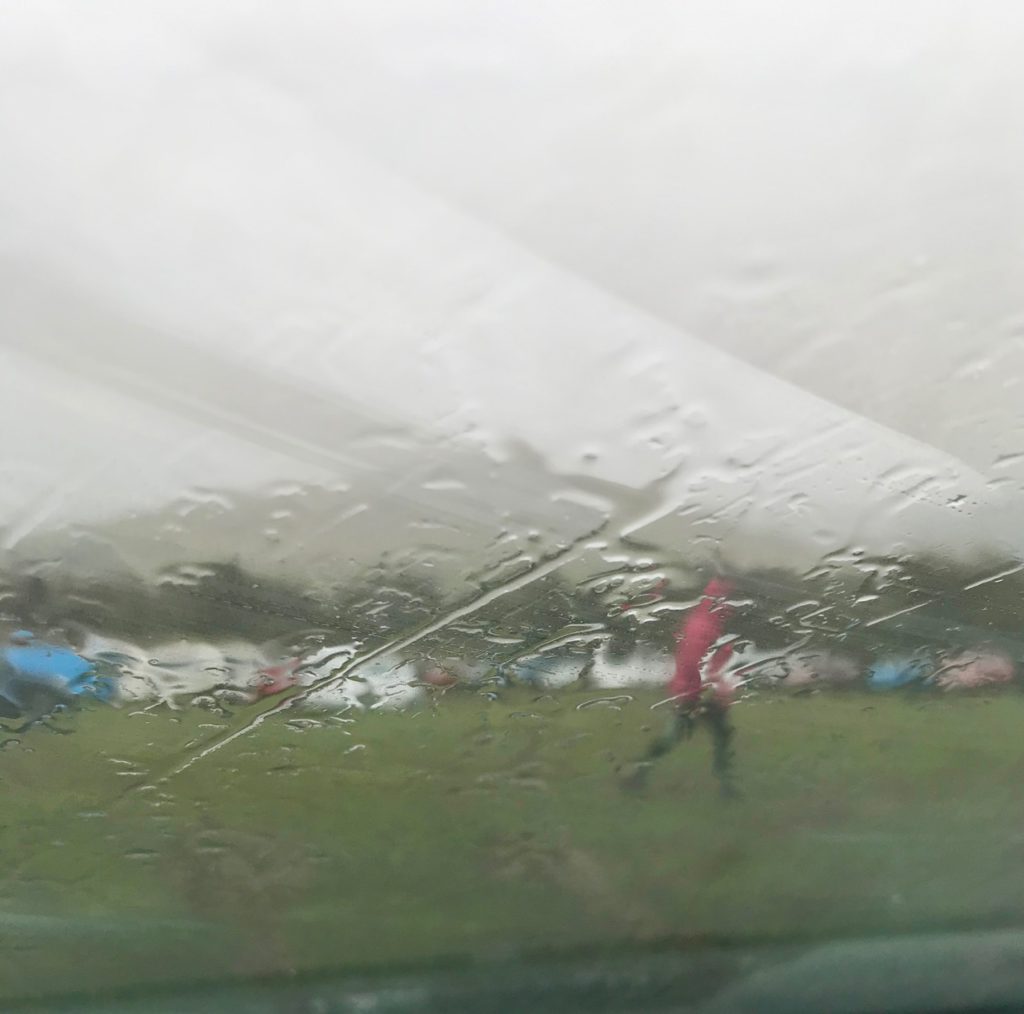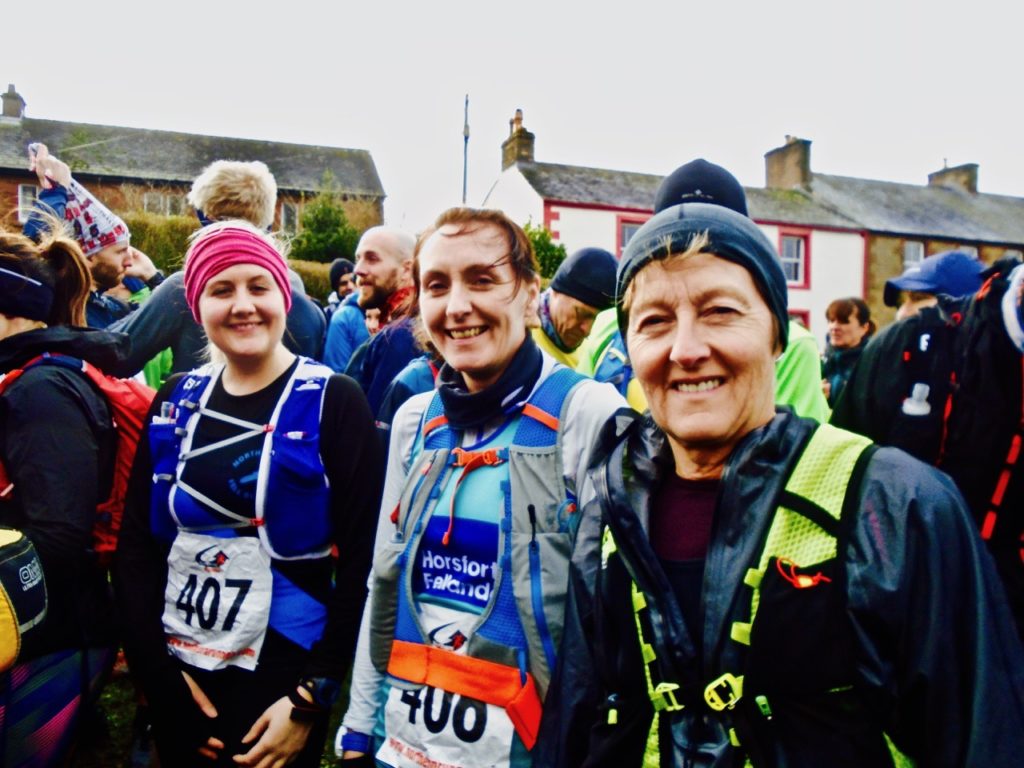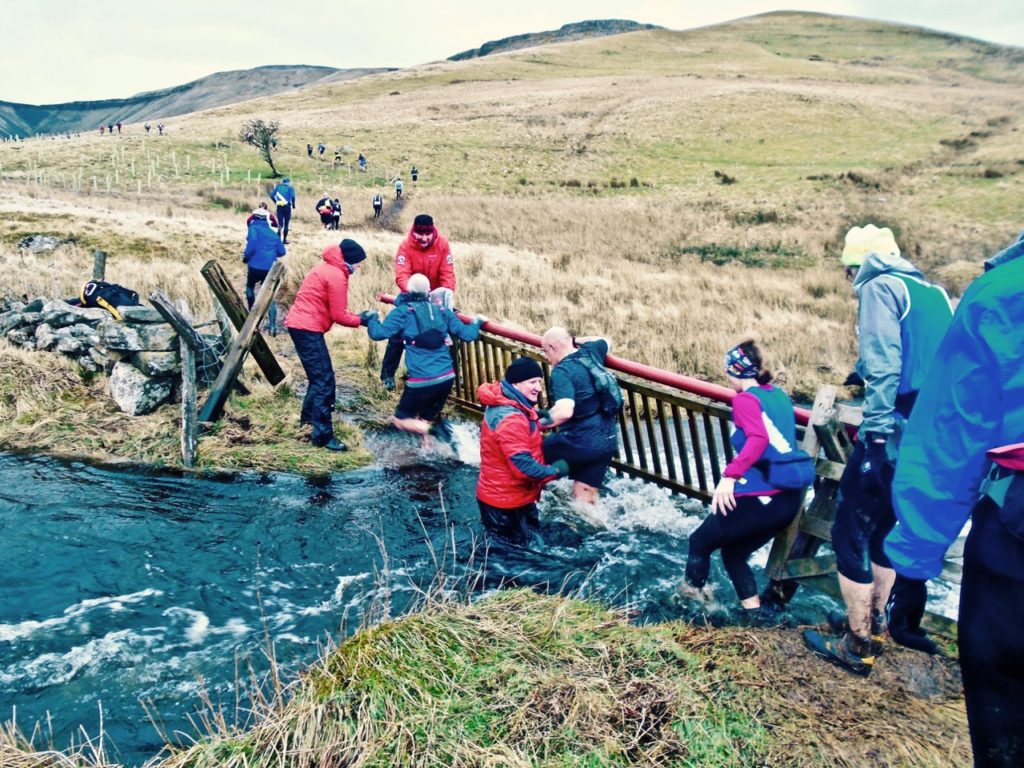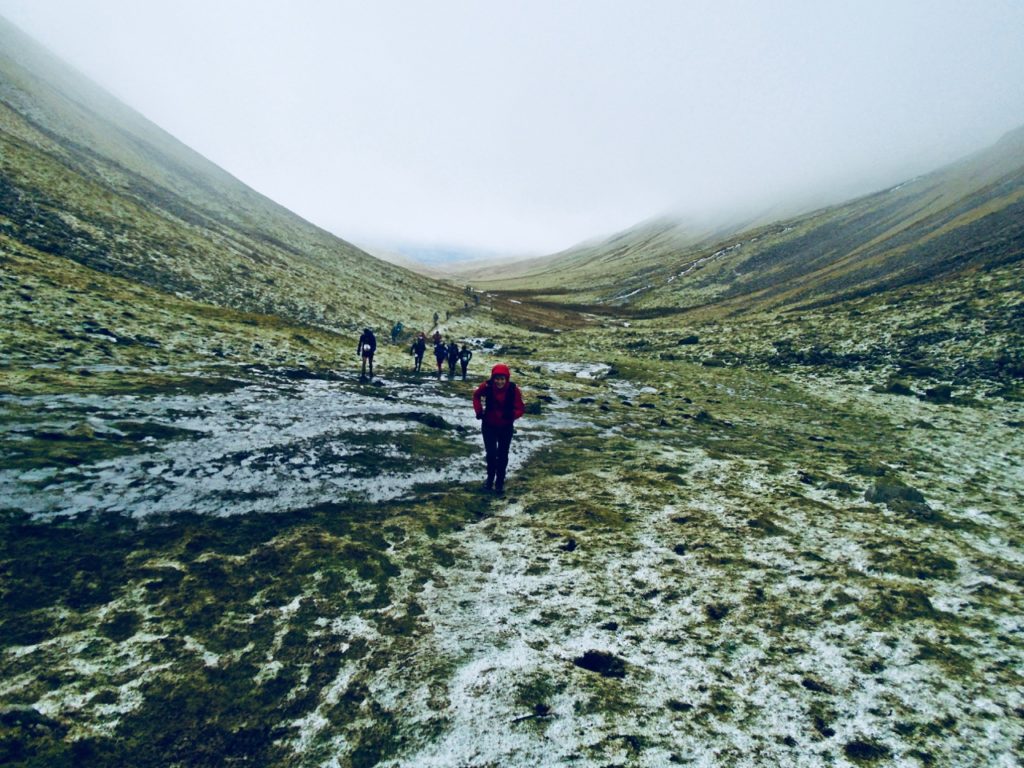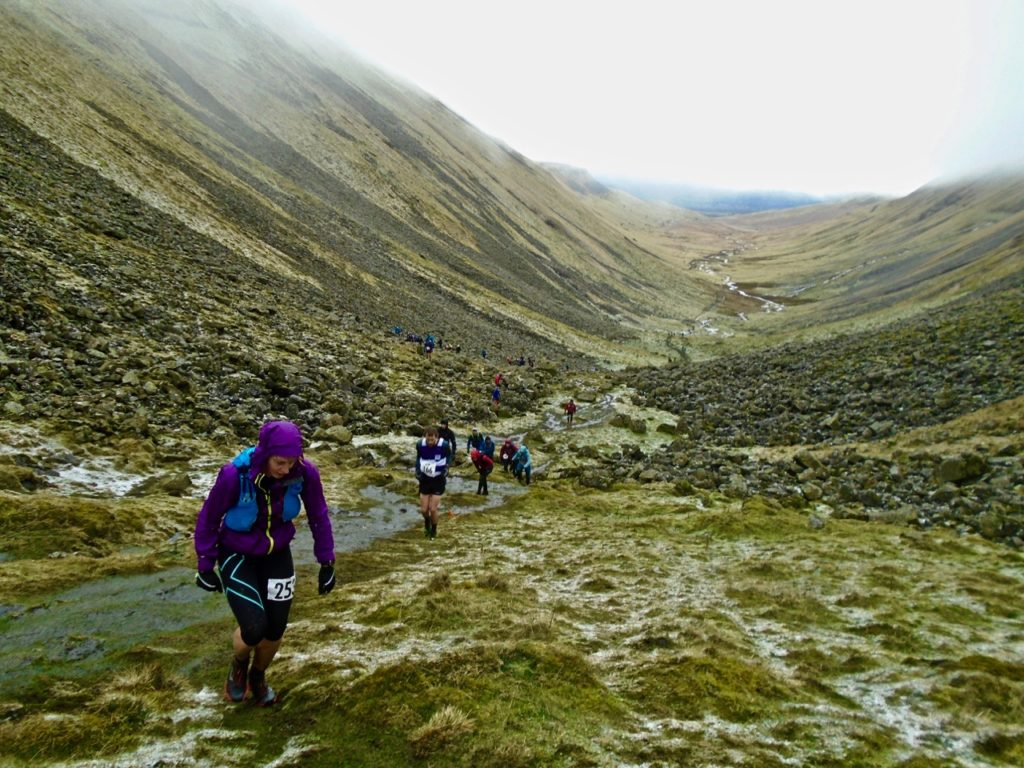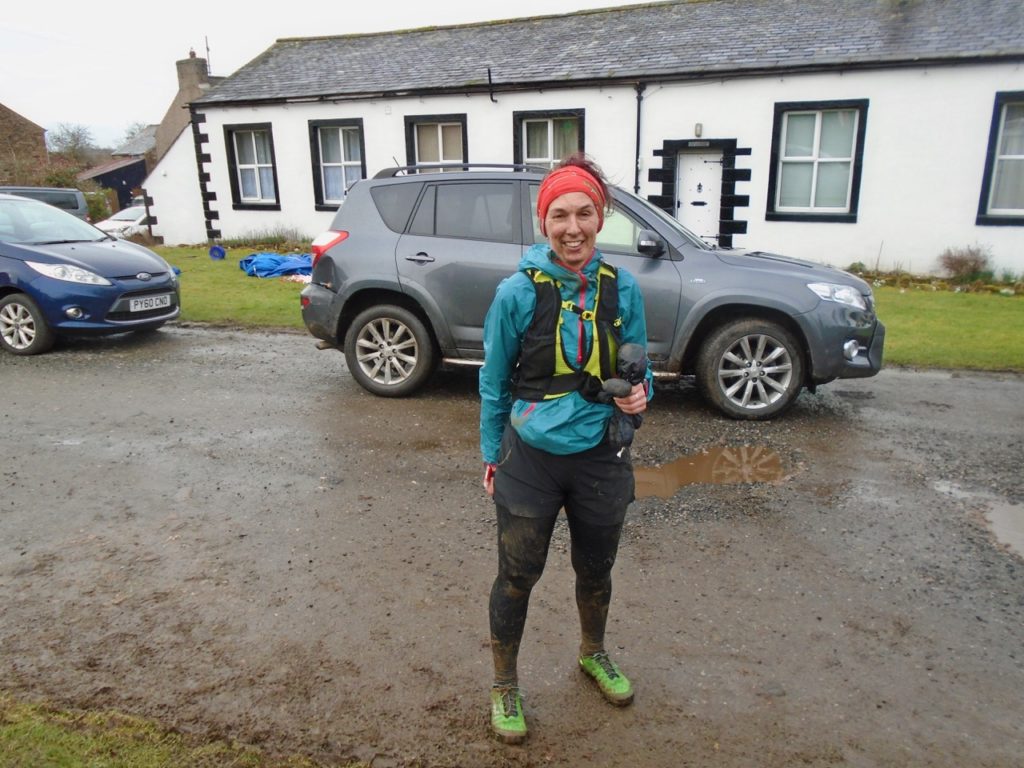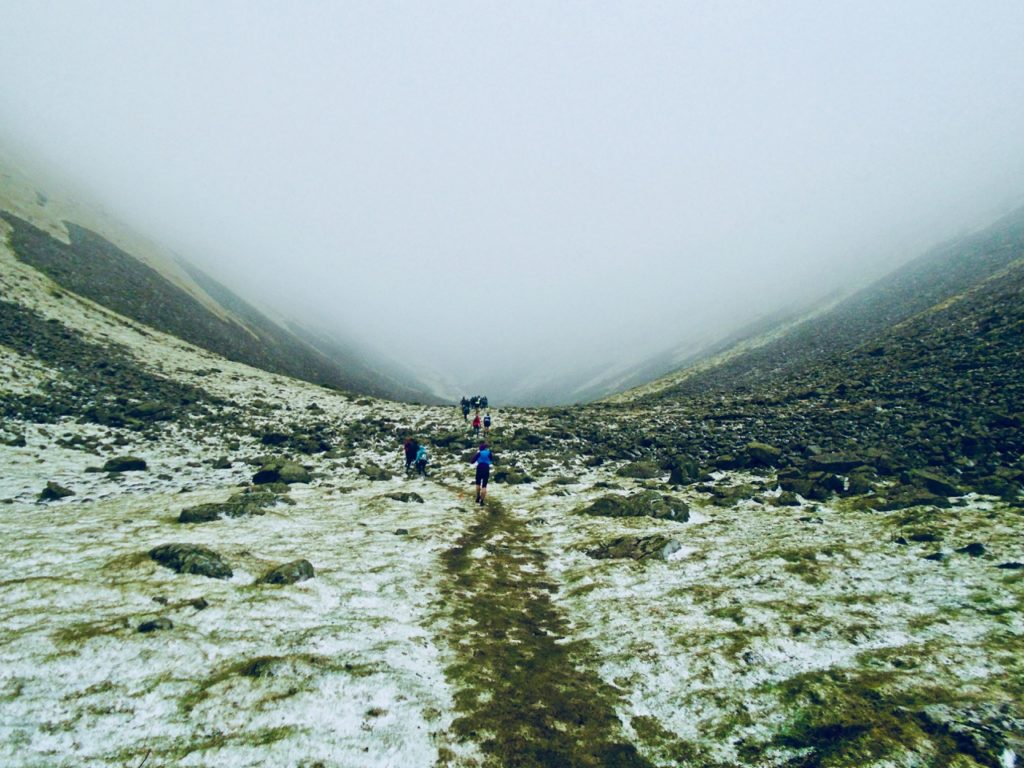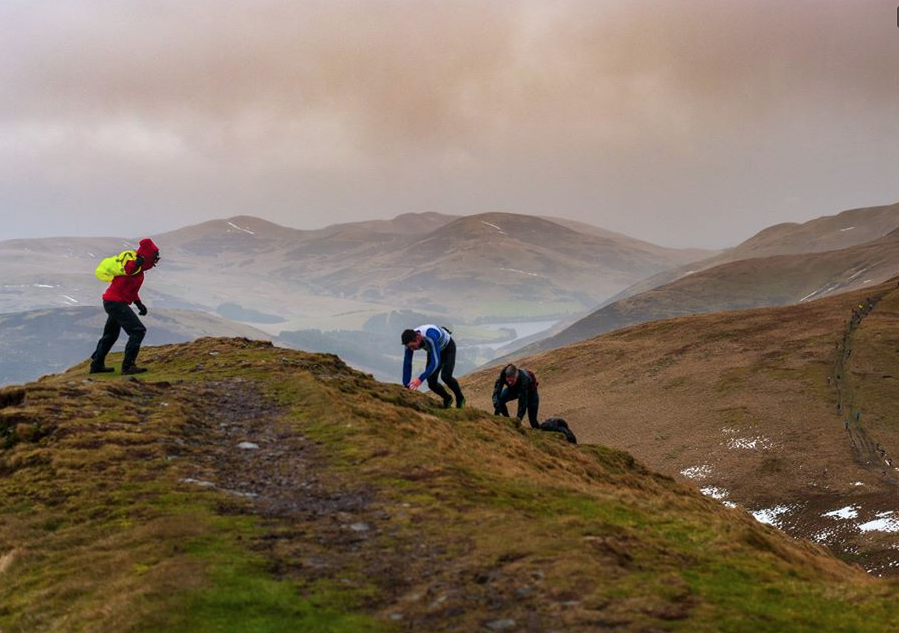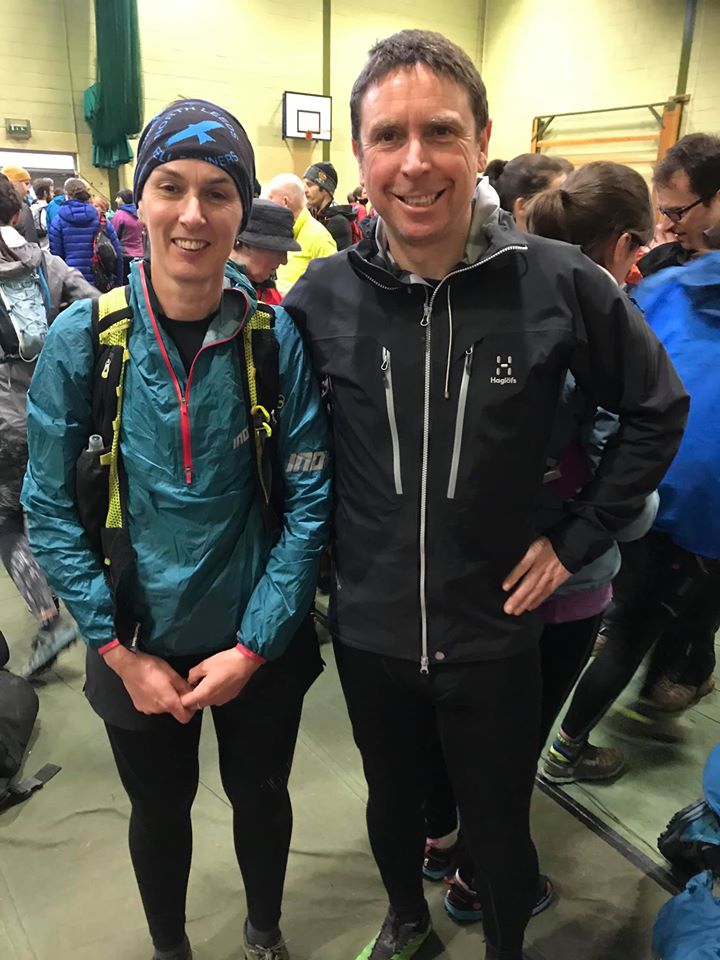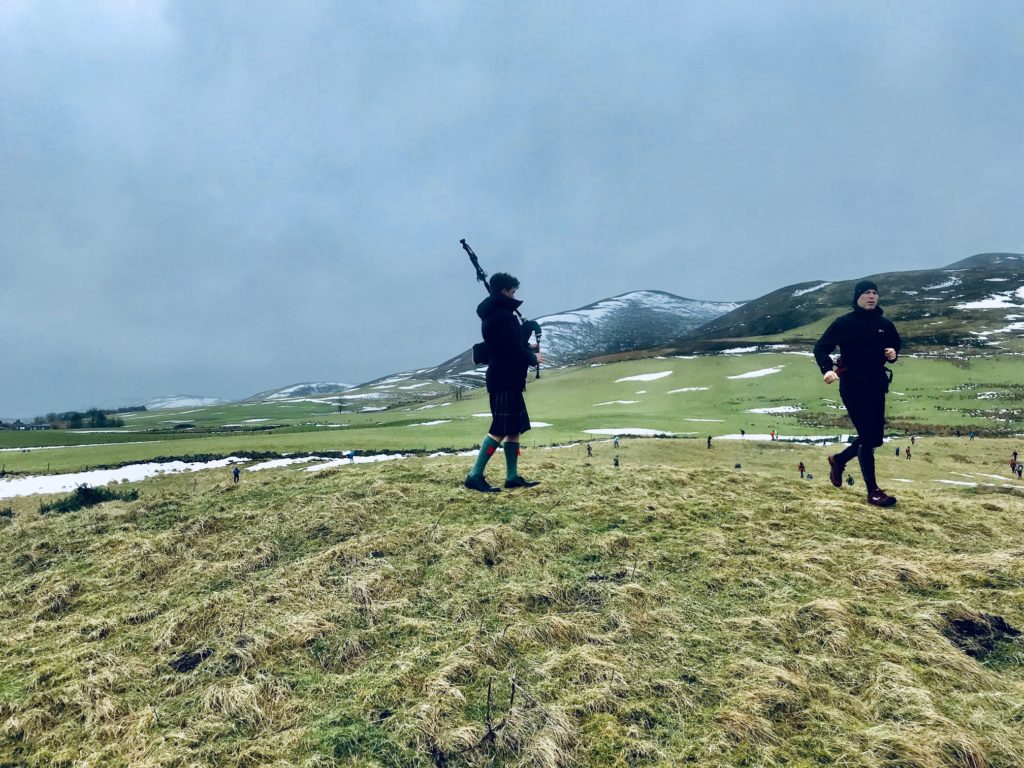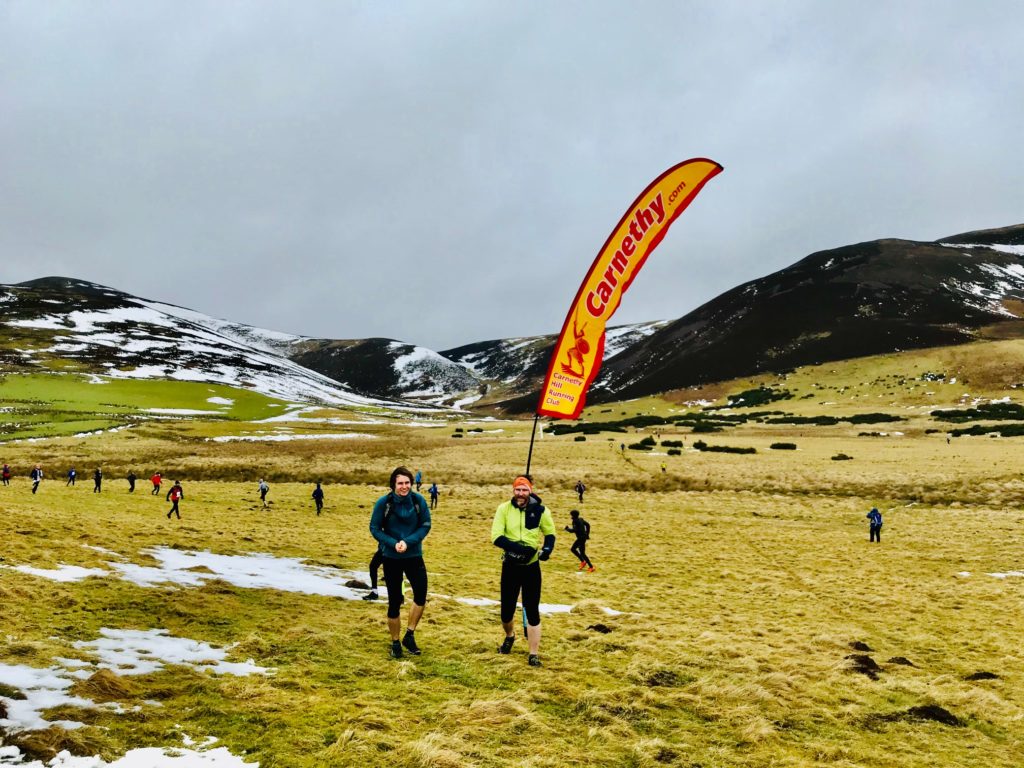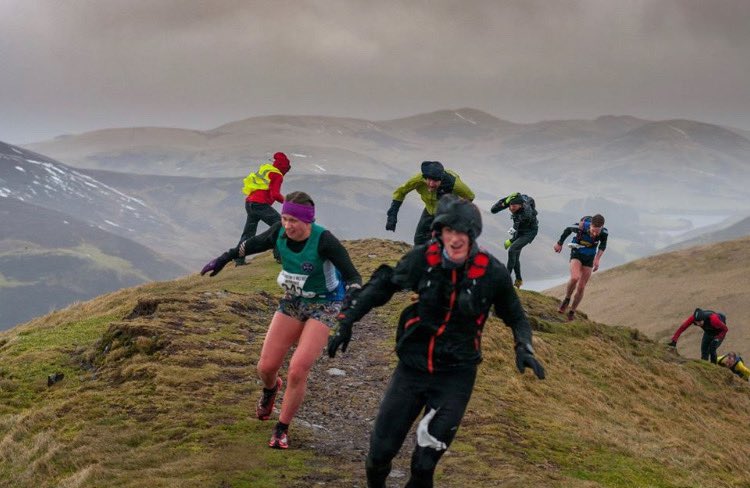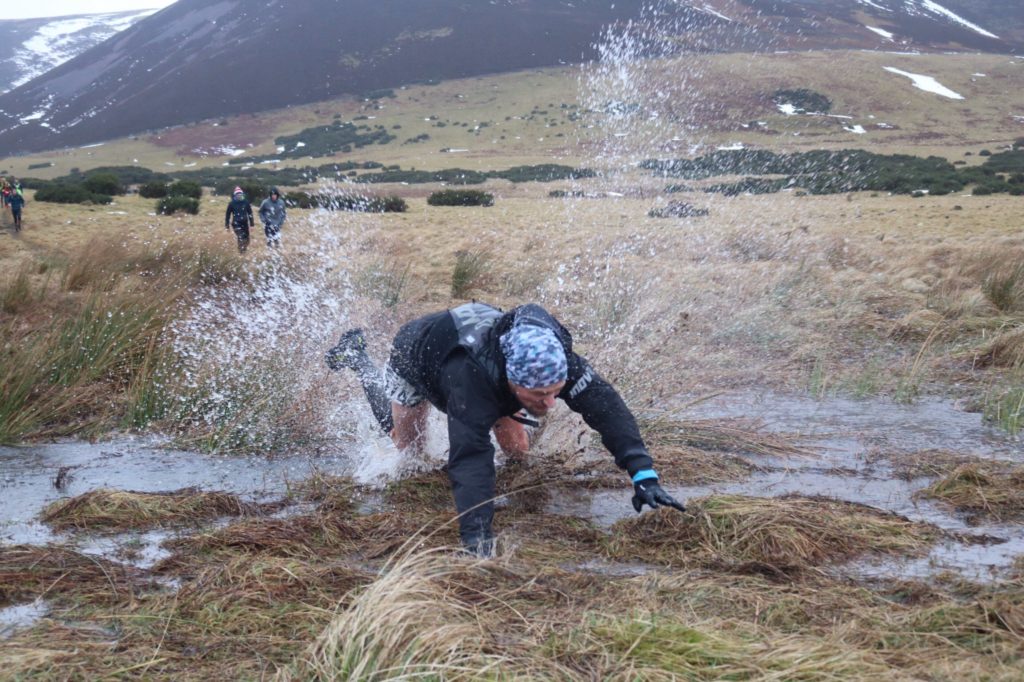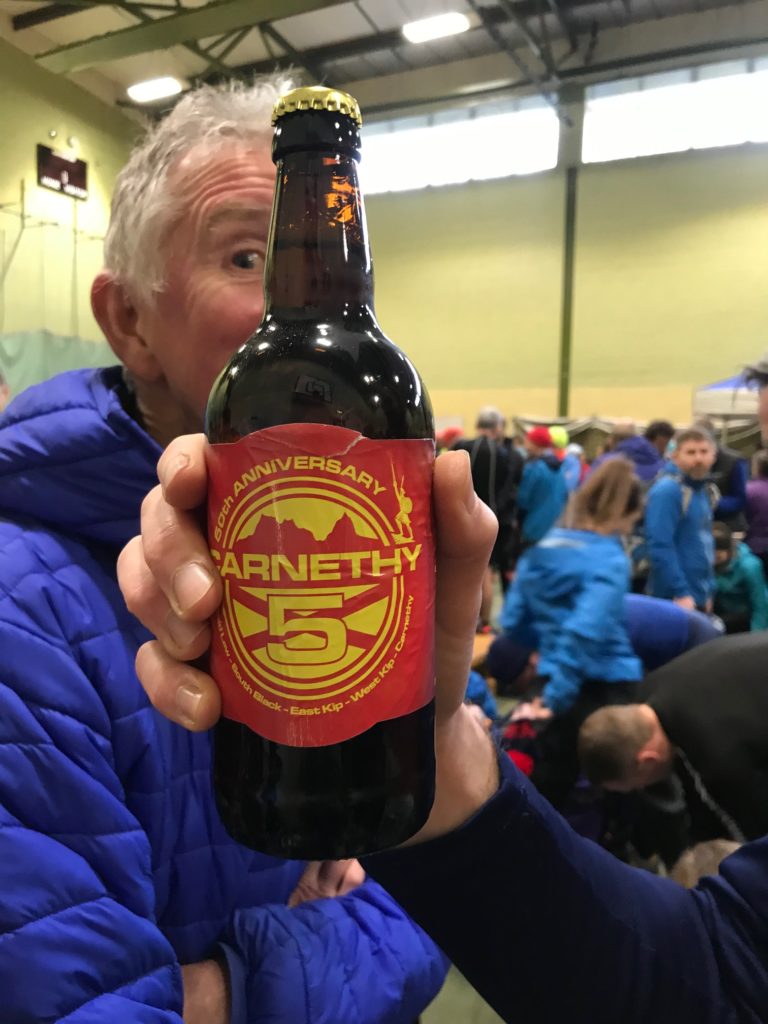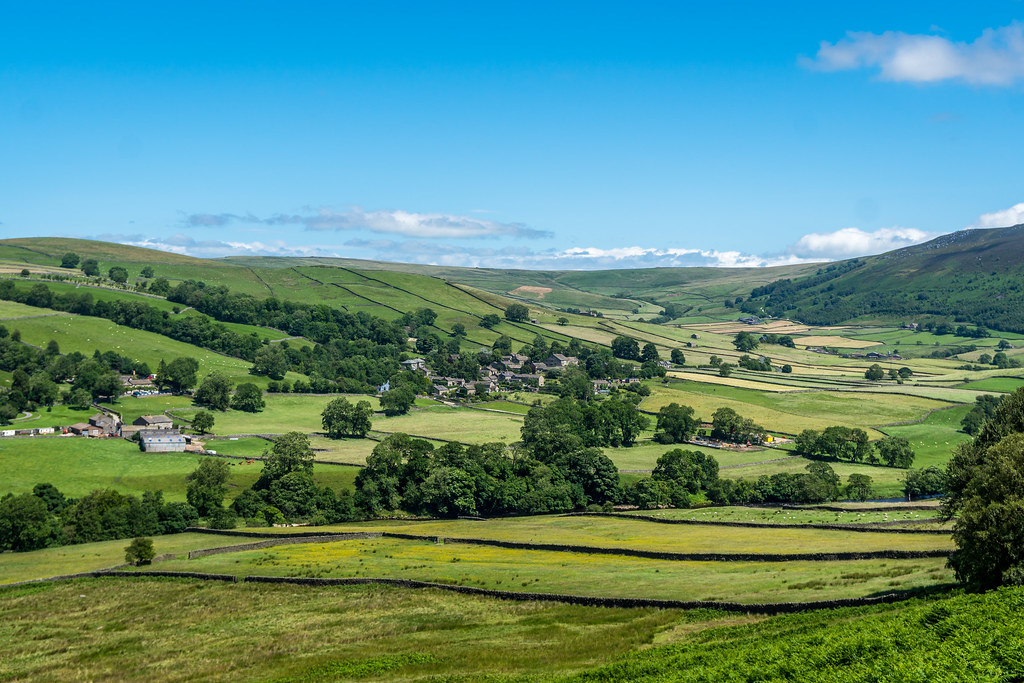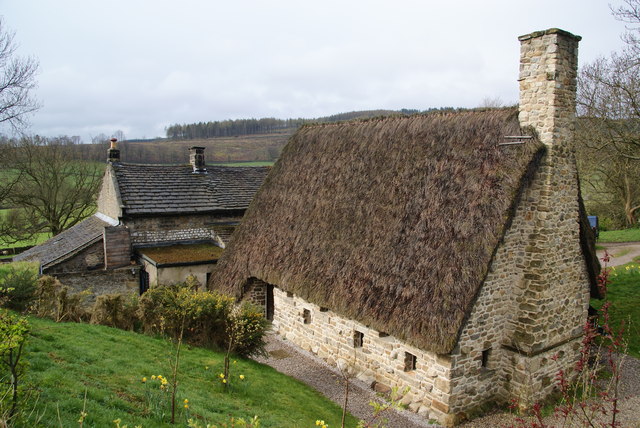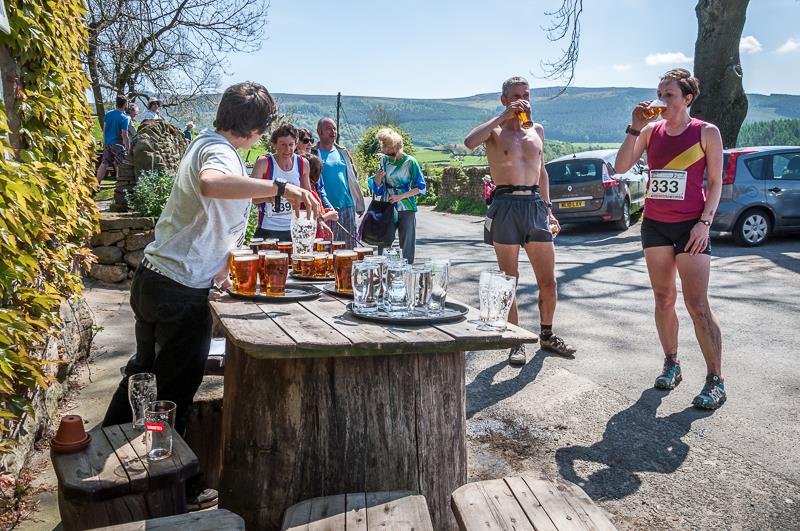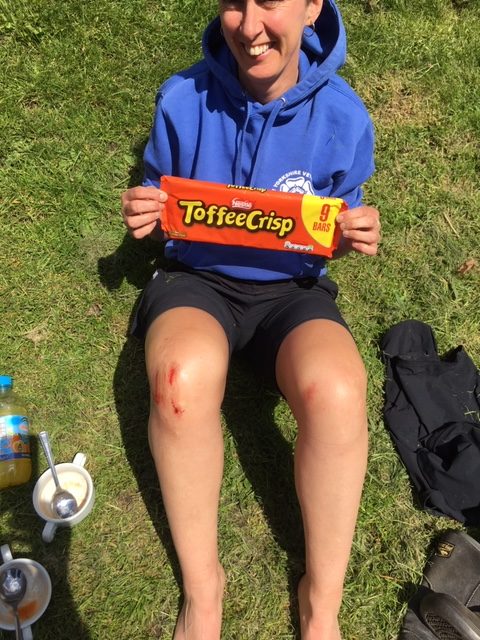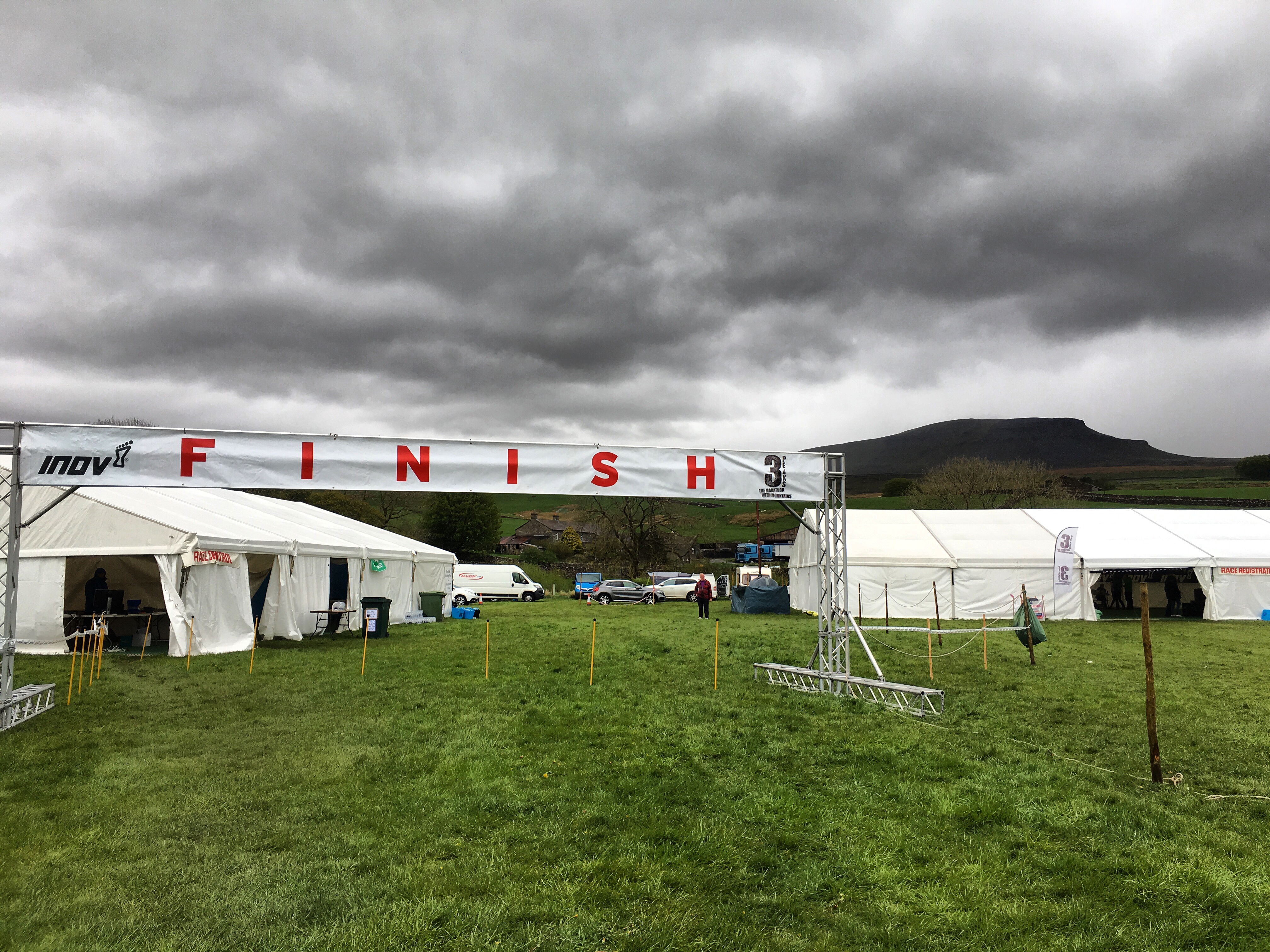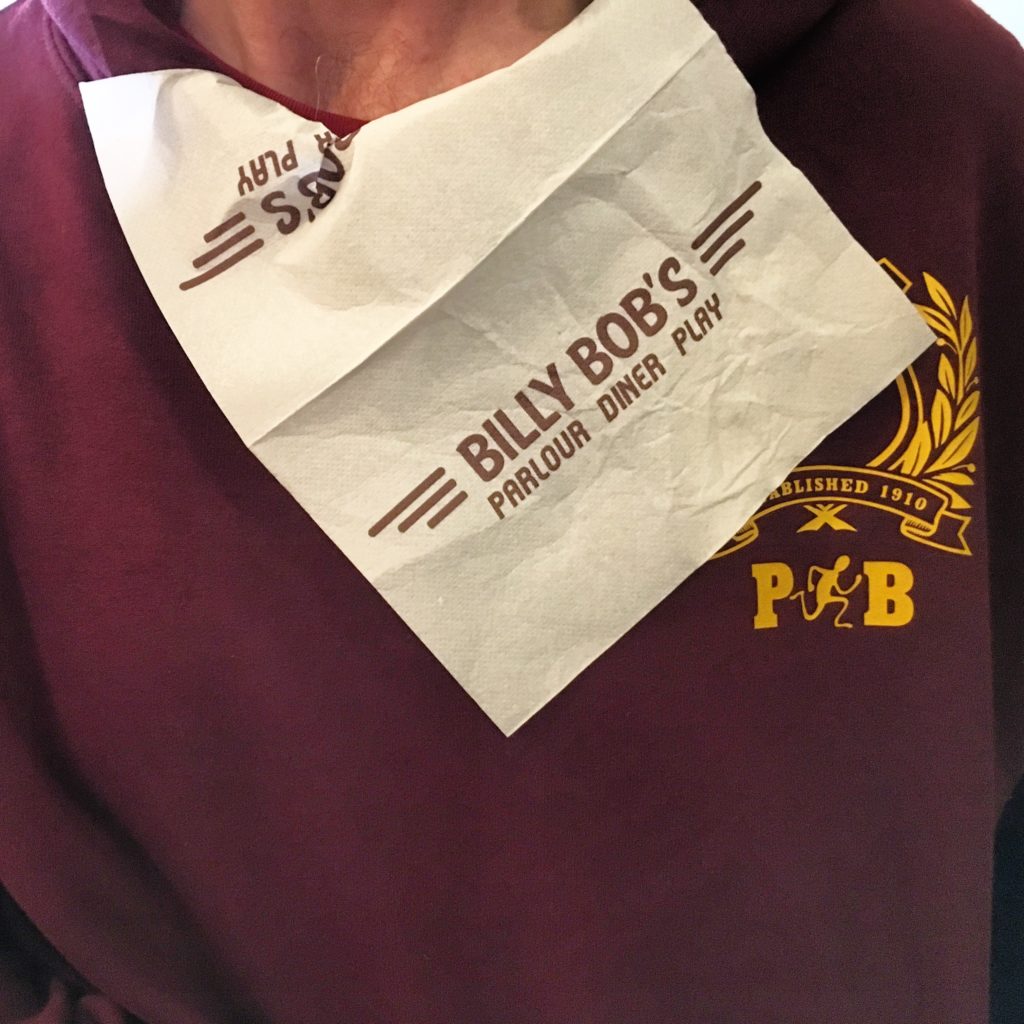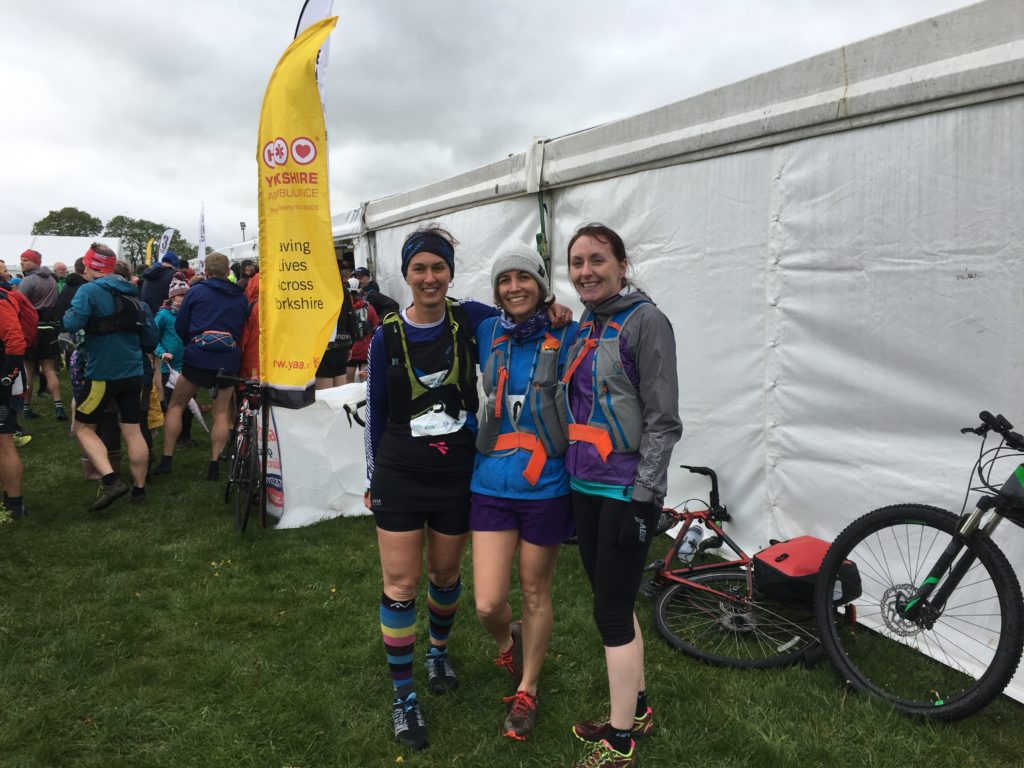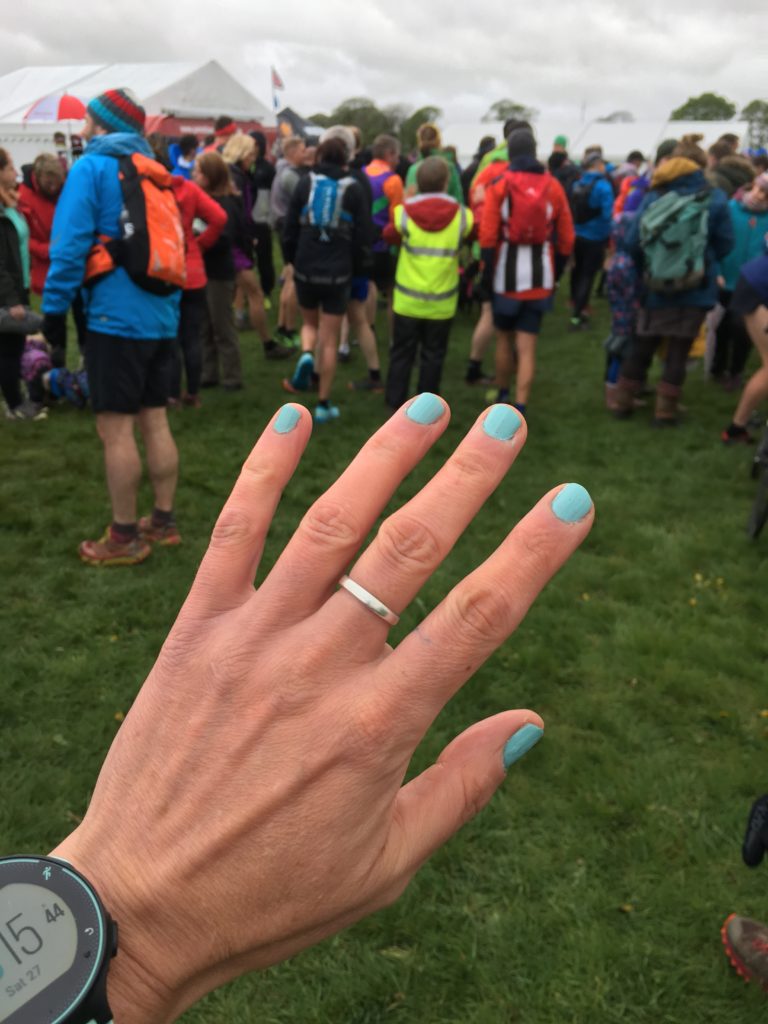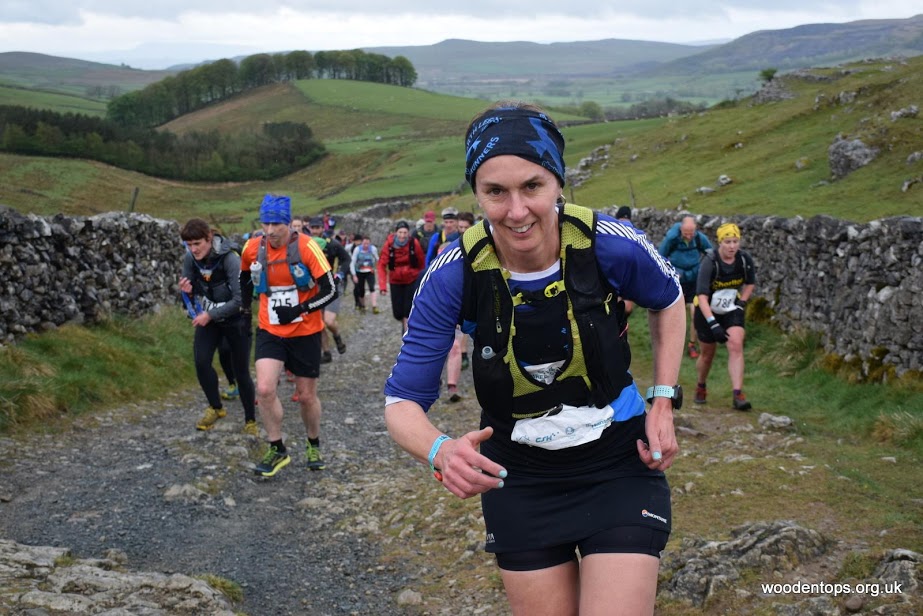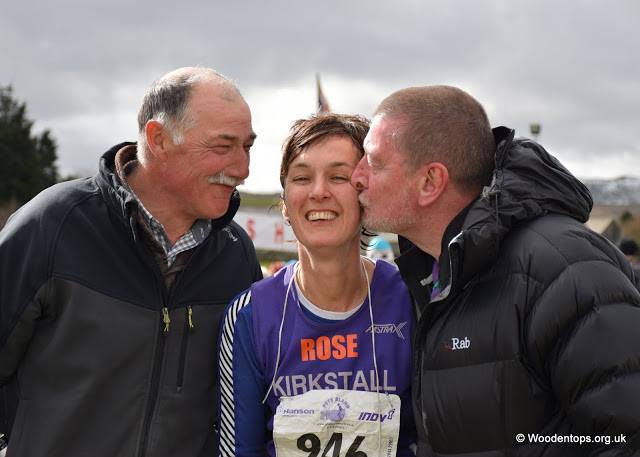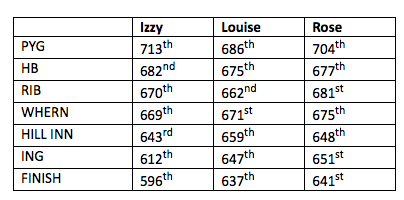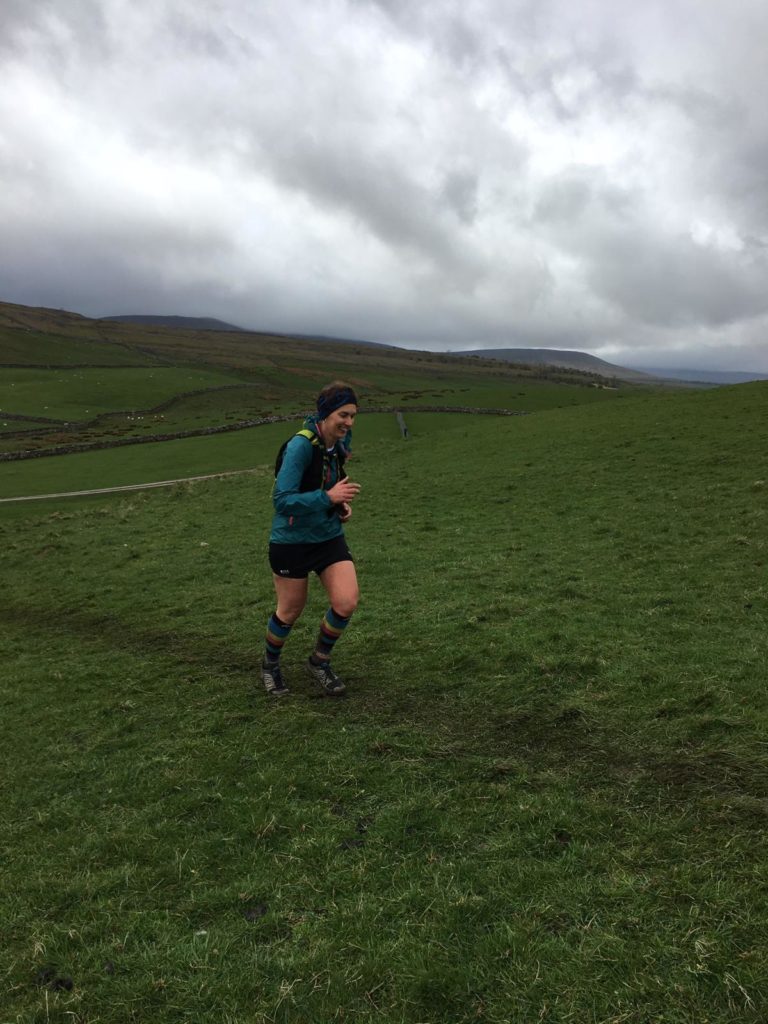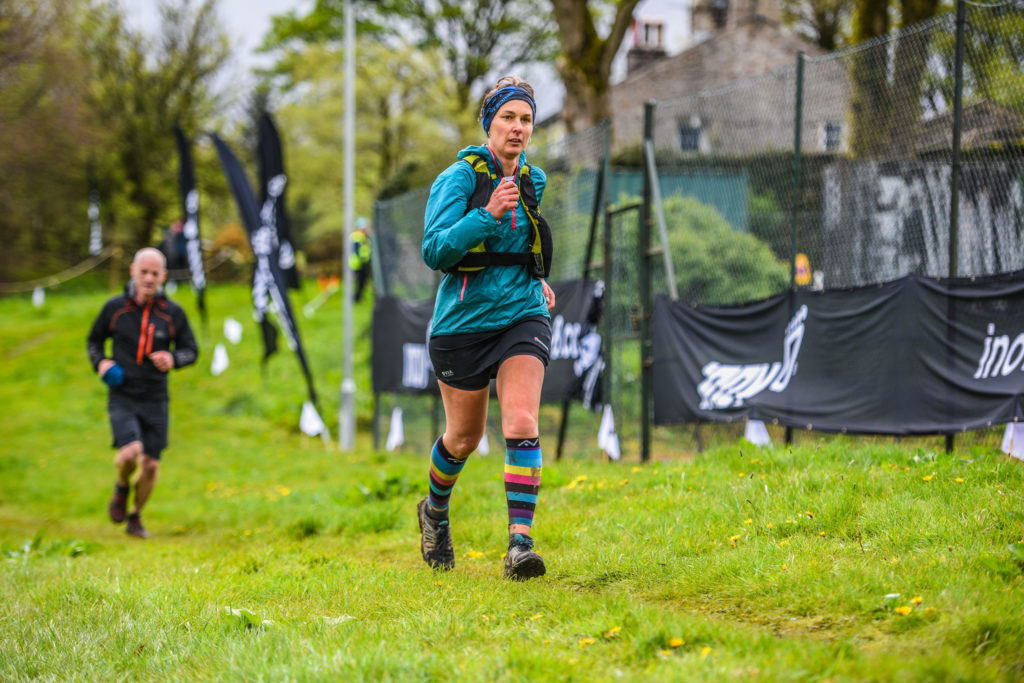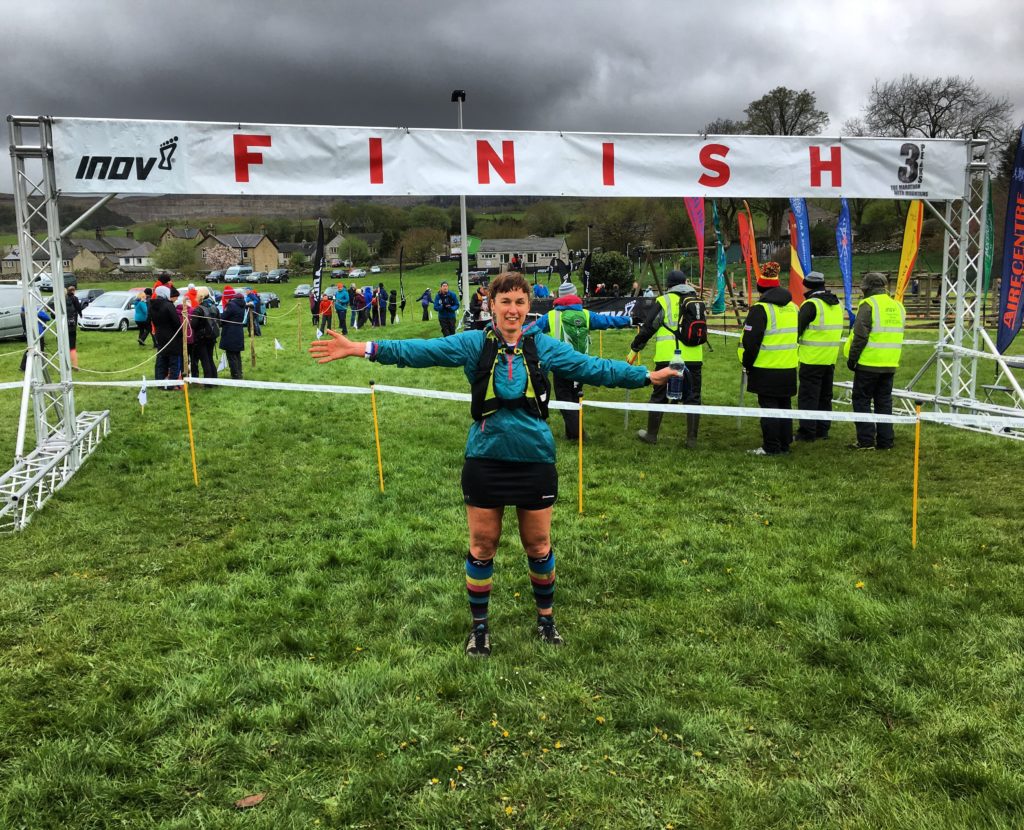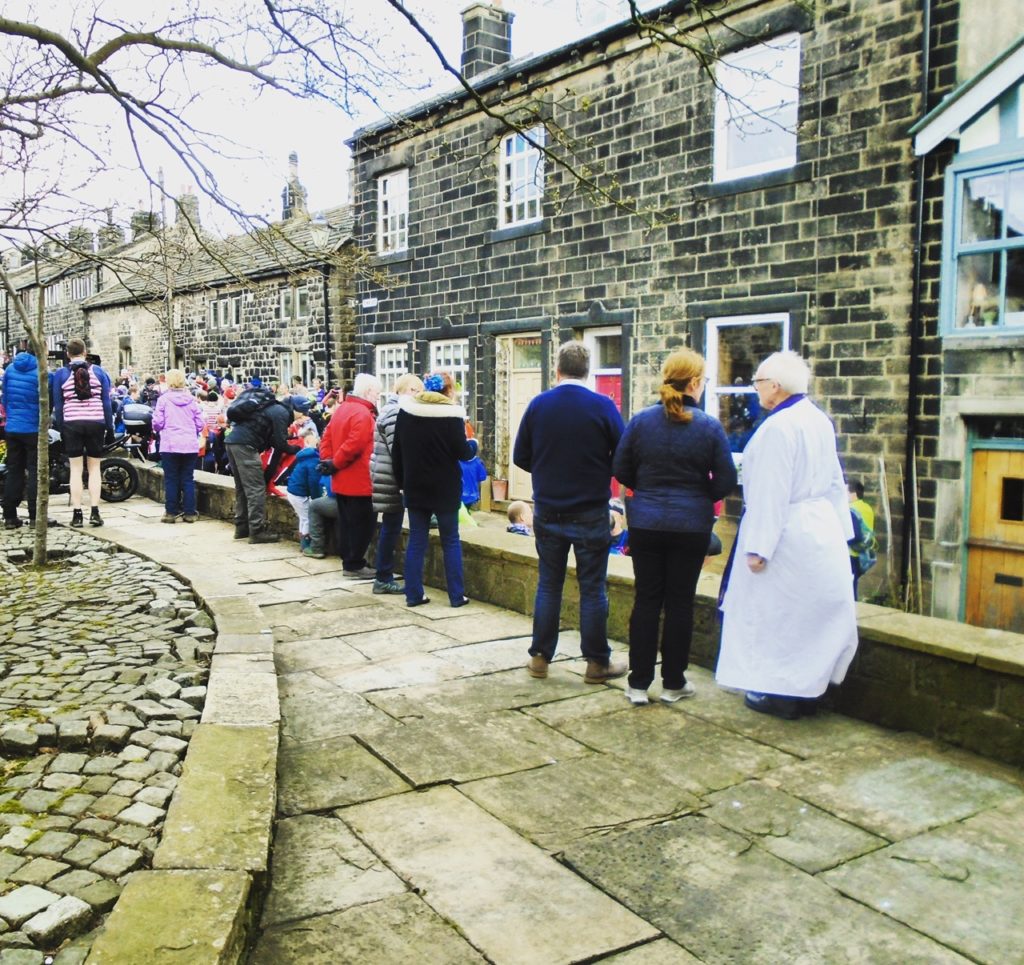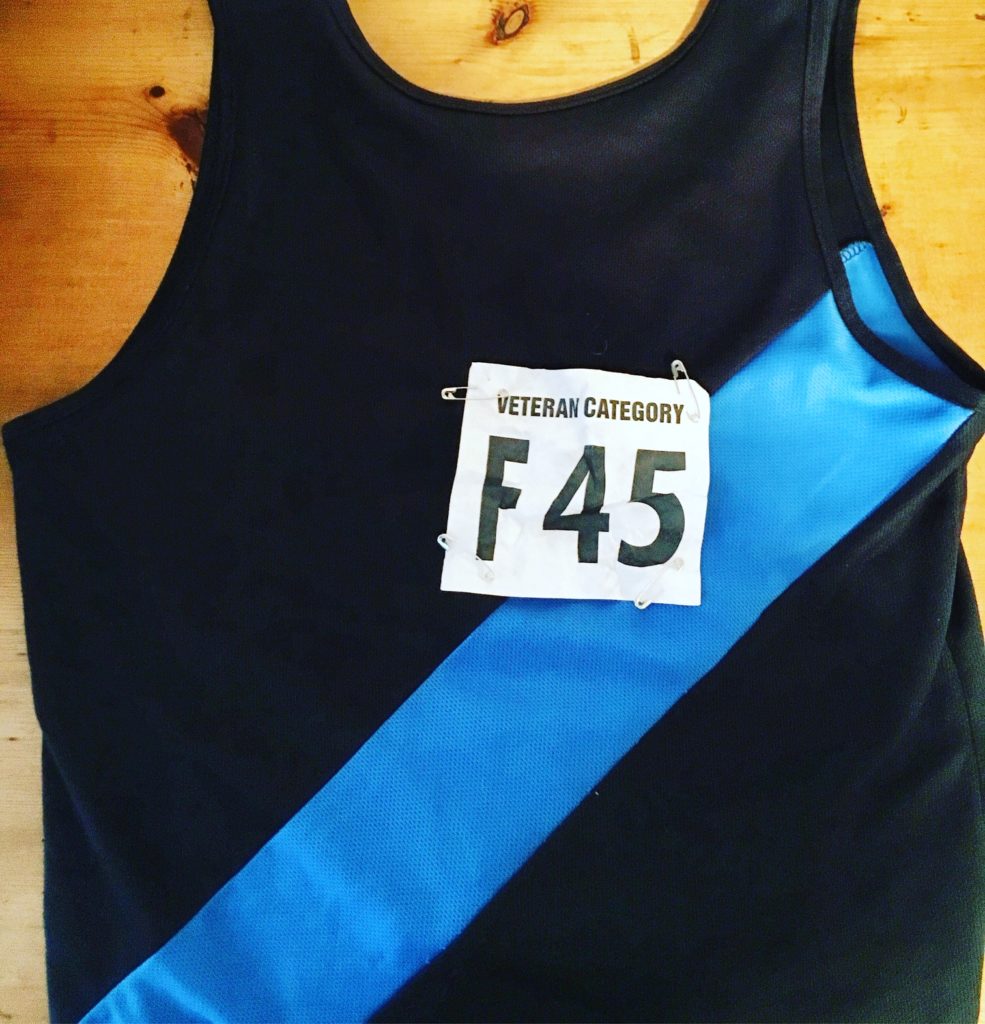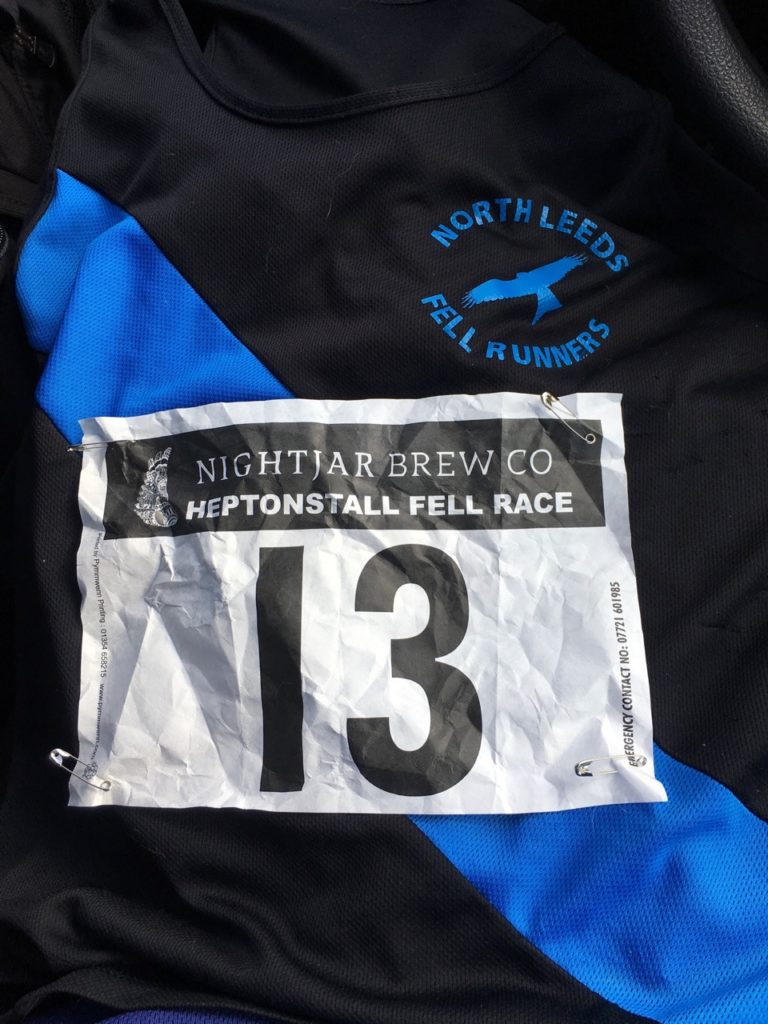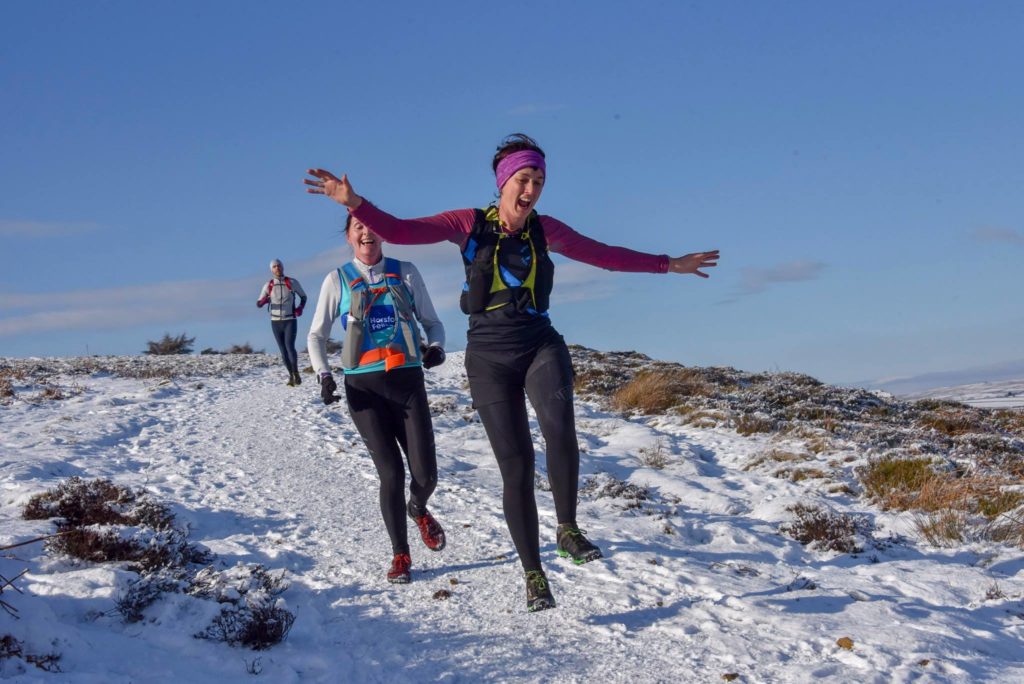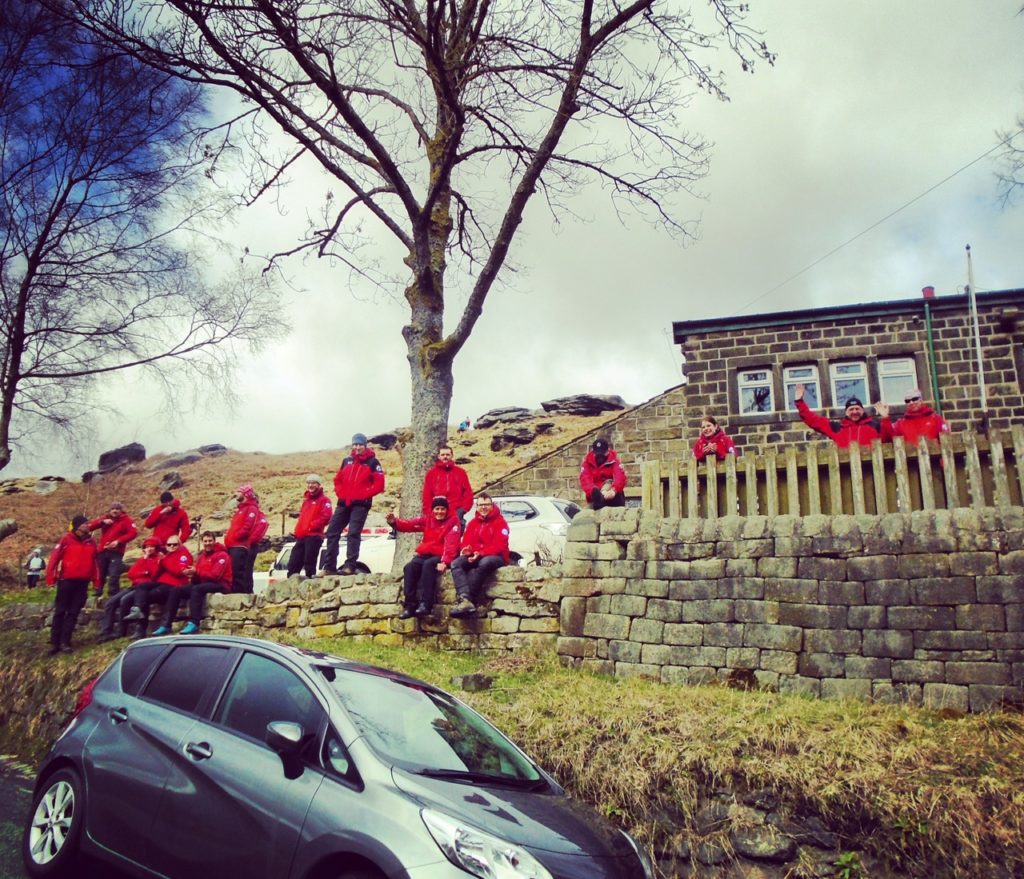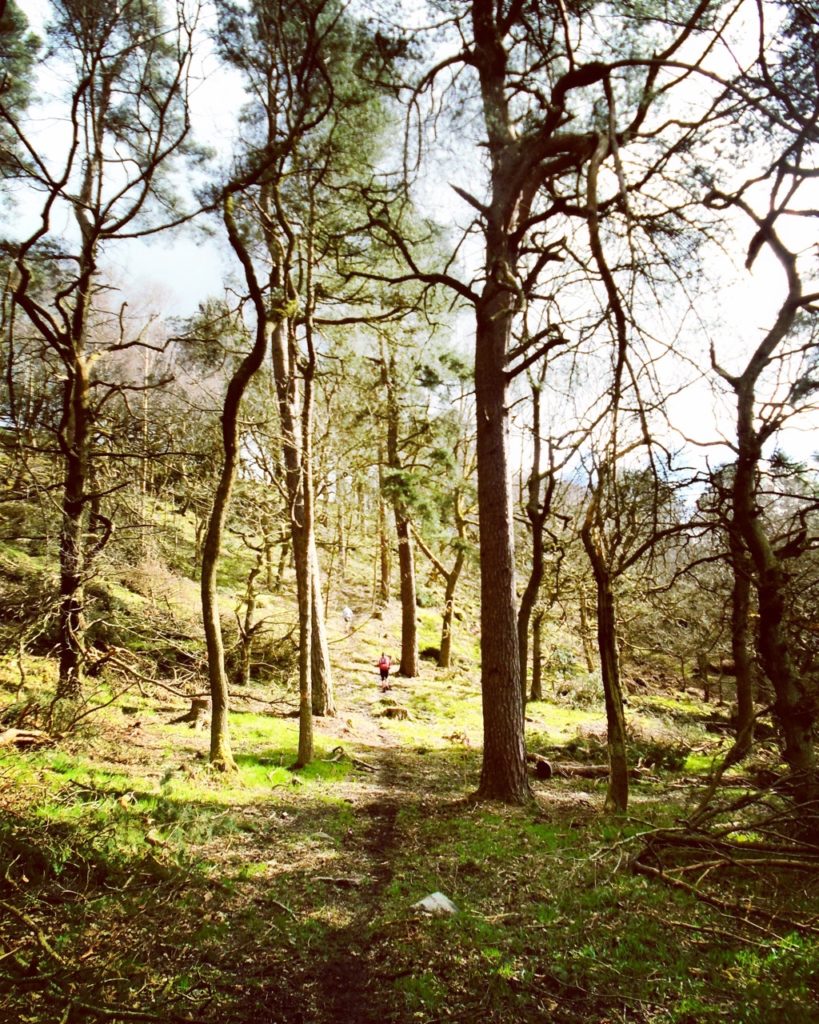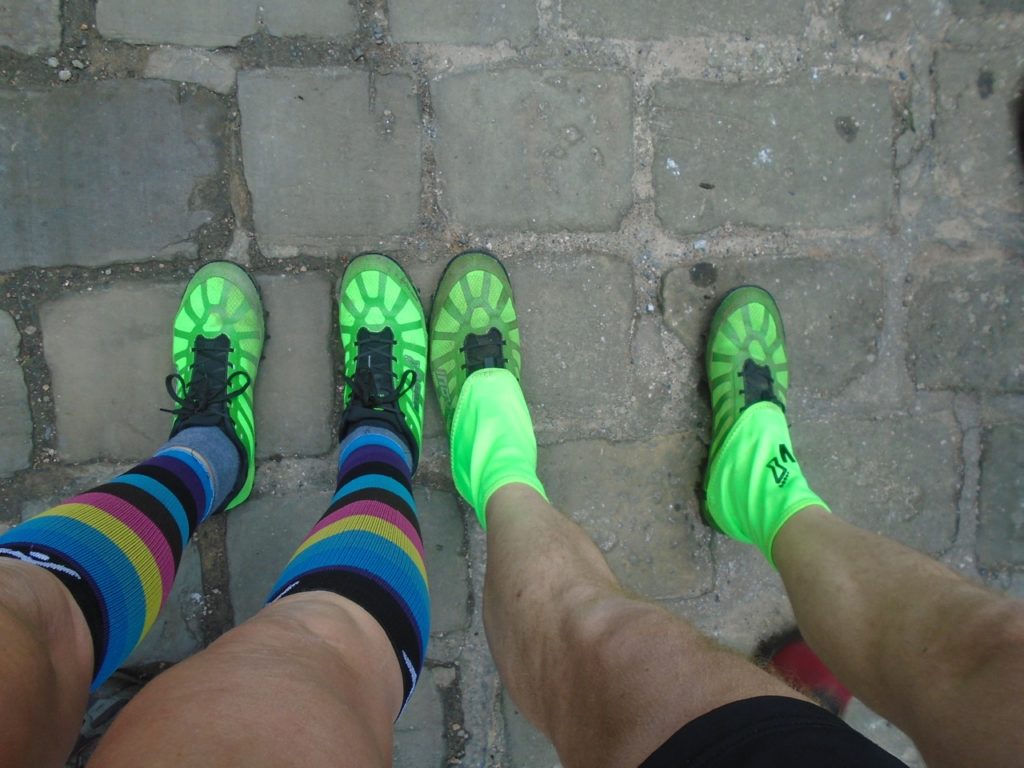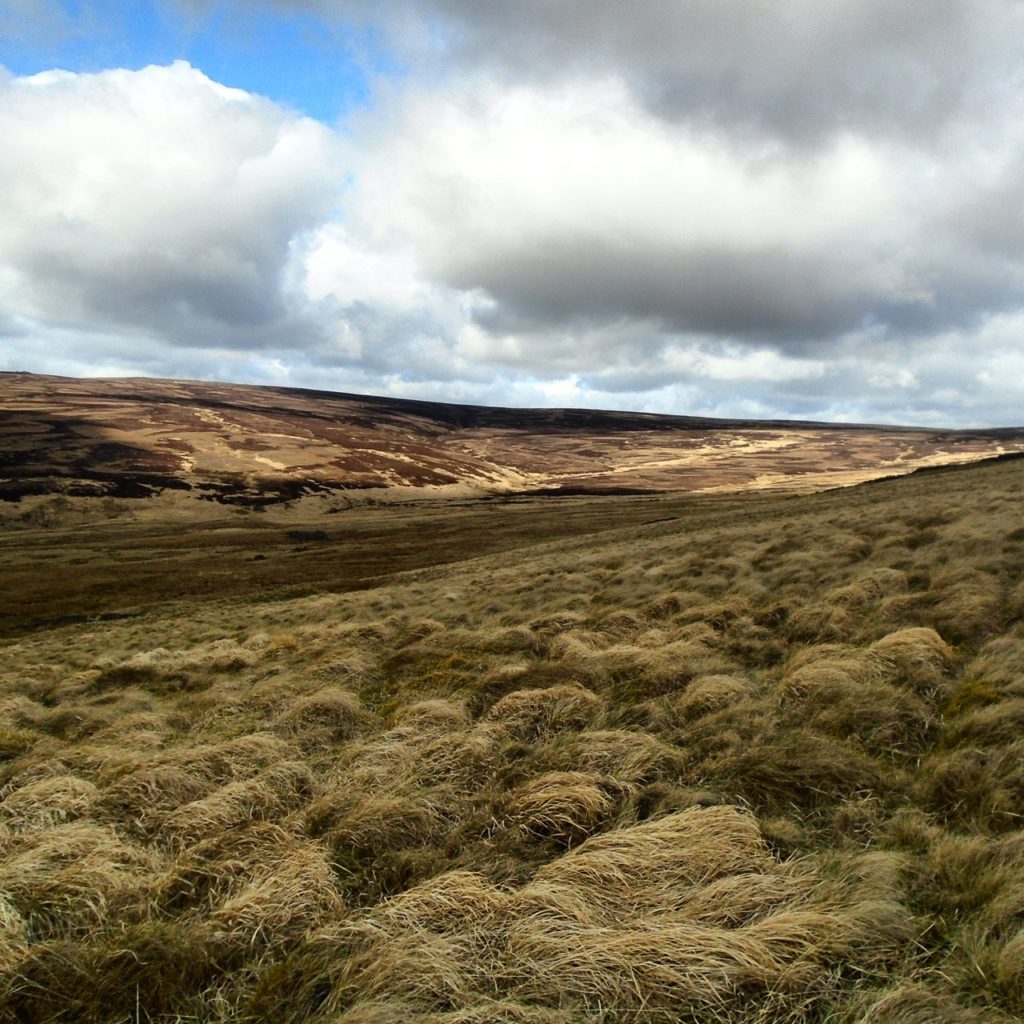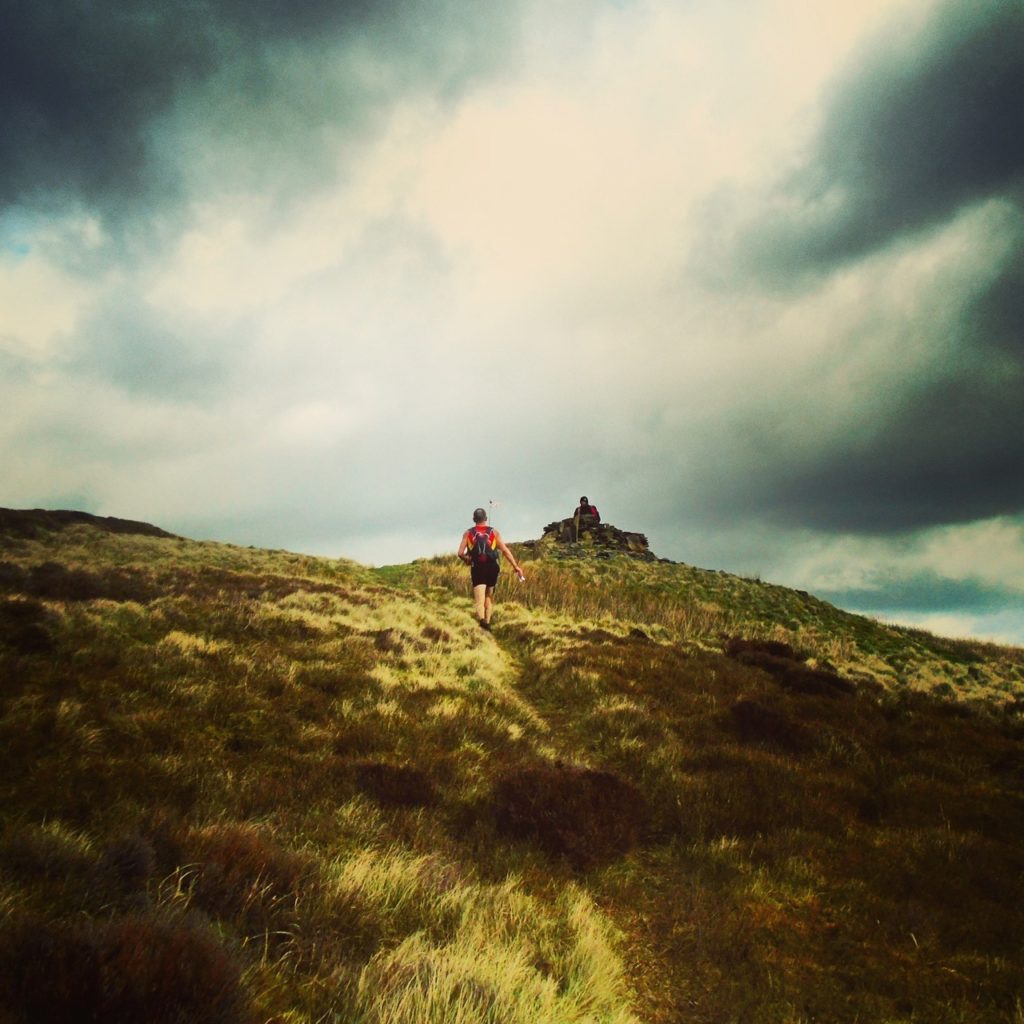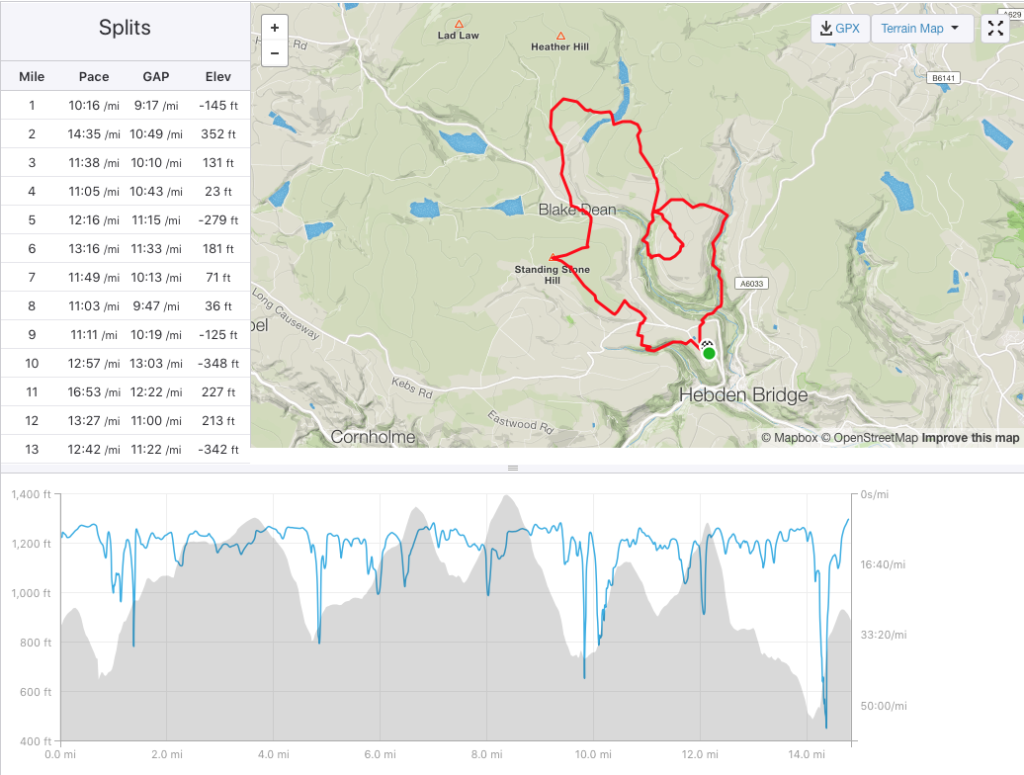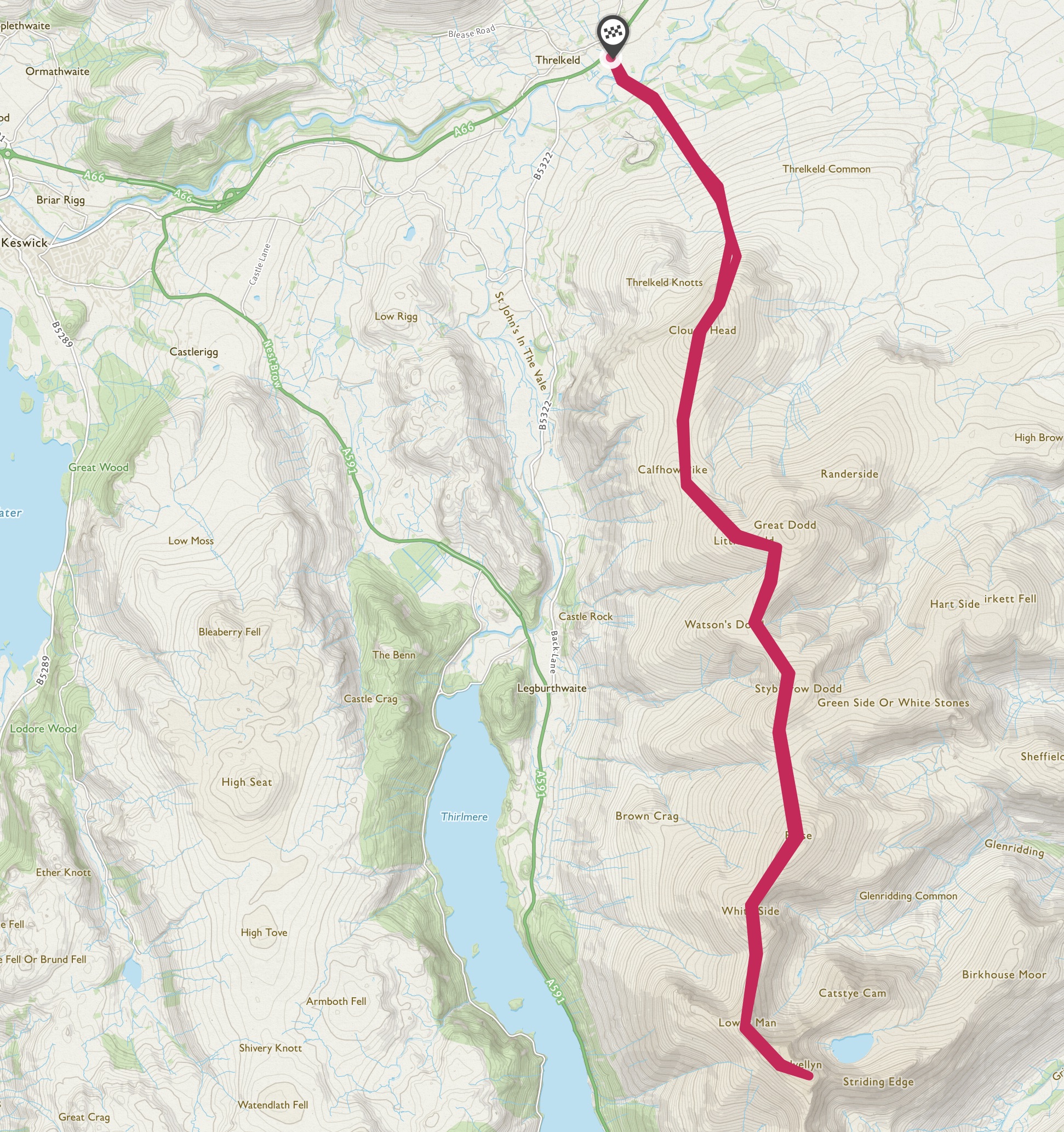45 miles, 6000 ft of ascent
Weather: 21 degrees falling to 18 degrees overnight with 80% humidity
by Rose George & Liz Casey
This run – a midsummer version of the annual winter Pendle Way in a Day – is purposefully held on the shortest night of the year, but only when that happens on a weekend. The next opportunity to do this will be 24th & 25th June 2028 so put it in your calendars.
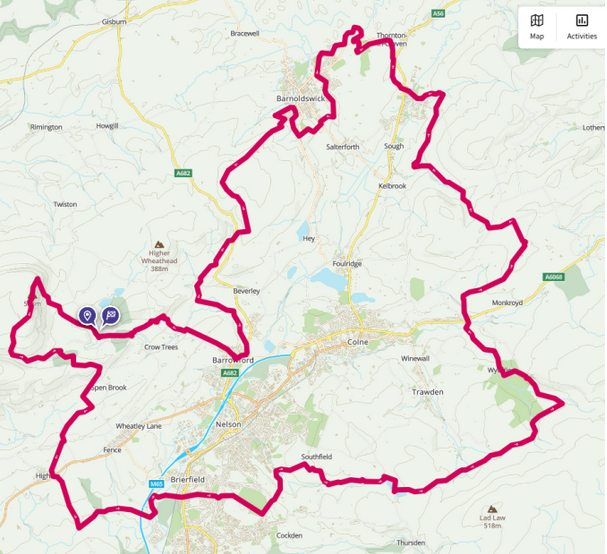
LIZ
The training started earlier in the year getting tough enough to do the distance and spend such a long time on our feet. During training, aside from the eating, drinking and what to wear on the day, Rose acquired some running poles. On occasion we found it hard to find a solution to carrying these when not in use so they were a) comfortable b) easy to access/store while moving c) didn’t rattle around. Rose announced on event day she had found a solution for all the above.
OMG! Was she right…. A quiver…yes a proper quiver…. I think my excitement at this item of her kit made the whole event so much more fun.
ROSE
I’m not sure whether I spent more time training or googling solutions for carrying running poles. Joke. I definitely spent more time training, for once. Top tip for when you realise you have made a commitment (I still can’t remember why) to run 45 miles overnight: get a coach and a training plan. Both Liz and I had plans drawn up by Run Brave aka Neil Wallace (aka my partner), and amazingly, we both followed them pretty closely. They featured circuit breakers (intervals, then hill climb “circuit breakers” then more intervals), pace management, time on feet and the hardest but probably most useful: the split long run. I did two of these: the first consisted of me running Leg 5 of the Calderdale Way Relay with Martha, on a punishingly hot day, then driving home and making myself run another 6 miles. Of course this was all about increasing mental grit as well as physical endurance. The second had me doing 12 miles in the morning then spending the rest of the day trying not to make myself wimp out of getting out at 8pm and doing another 12 miles. I did it, and really enjoyed it. By the time we got to race day, I had no idea how I was going to stay awake overnight let alone run 45 miles, but I couldn’t have trained much better. Also, I had a quiver. (£14.99 from Decathlon.)
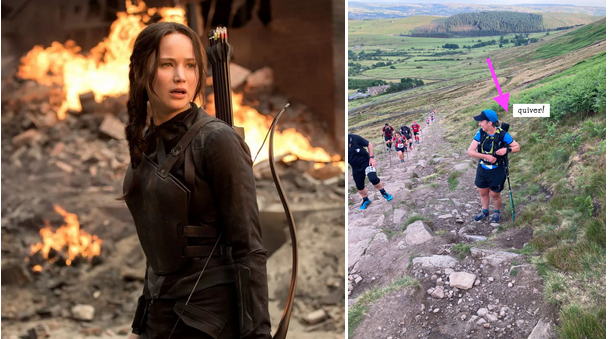
Rose (L) and Katniss (R)
LIZ
The race started at 8pm on Saturday evening from Barley and headed straight up Pendle Hill. As we ascended Rose pulled her poles from her quiver and snapped them into place like cracking a whip and marched up Pendle Hill. All we needed was a bow and we would have been tributes in an episode of the Hunger Games. OK it didn’t quite happen so smoothly and we did not look anything like Katniss Everdeen and it was more of a “would you mind getting my poles out of my quiver please?” We did not care. The quiver provided fun (it actually worked very well too).
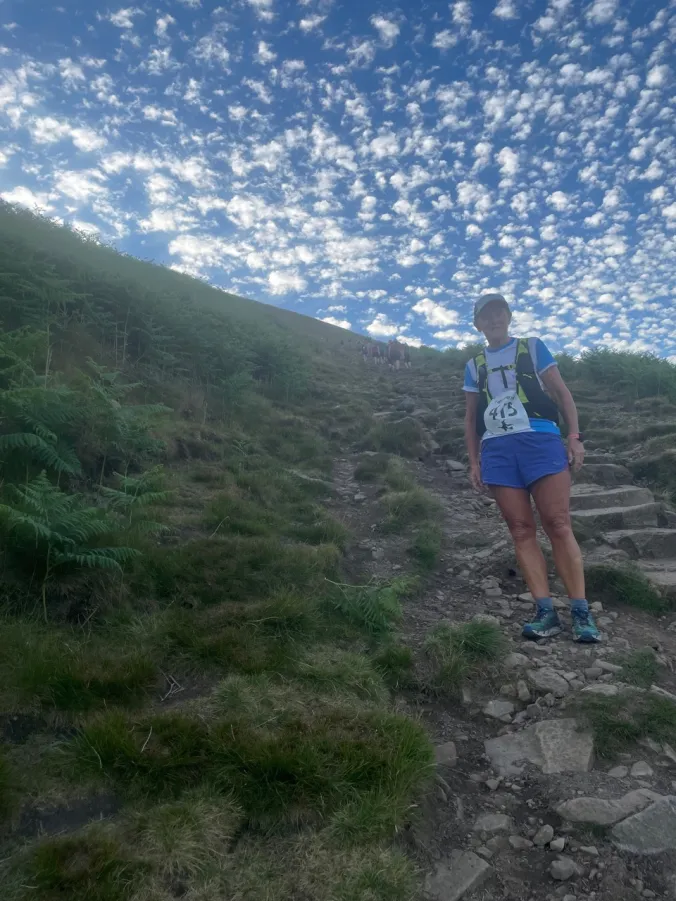
ROSE
There were about 80 runners milling about at the start outside Barley Village Hall, which I knew well from doing Tour of Pendle. There was an option to do a 30-mile route but I assumed most of these people were doing the 45. I had spent ages thinking about how much food to bring, as I was really worried that in the early hours the last thing my body would be expecting was food, yet I had to fuel properly and consistently. In hindsight, I had a stupid amount of food. I thought this might be the case when I saw that Liz had only a 5L pack, whereas I had a 10L stuffed to the gills, plus a waistpack. I had gels, powerballs, mint cake, sweets, veg sausages, salted boiled potatoes, a pouch of jelly, blister plasters, electrical tape, garden wire (you never know!), a powerbank (which I ended up needing for both watch and phone), two small bottles of flat coke, full kit plus an extra t-shirt. And toilet paper. I’d originally had a long-sleeve but the forecast was that it would feel like 23 degrees at 2am and be 80 percent humidity. Bye bye long-sleeve.
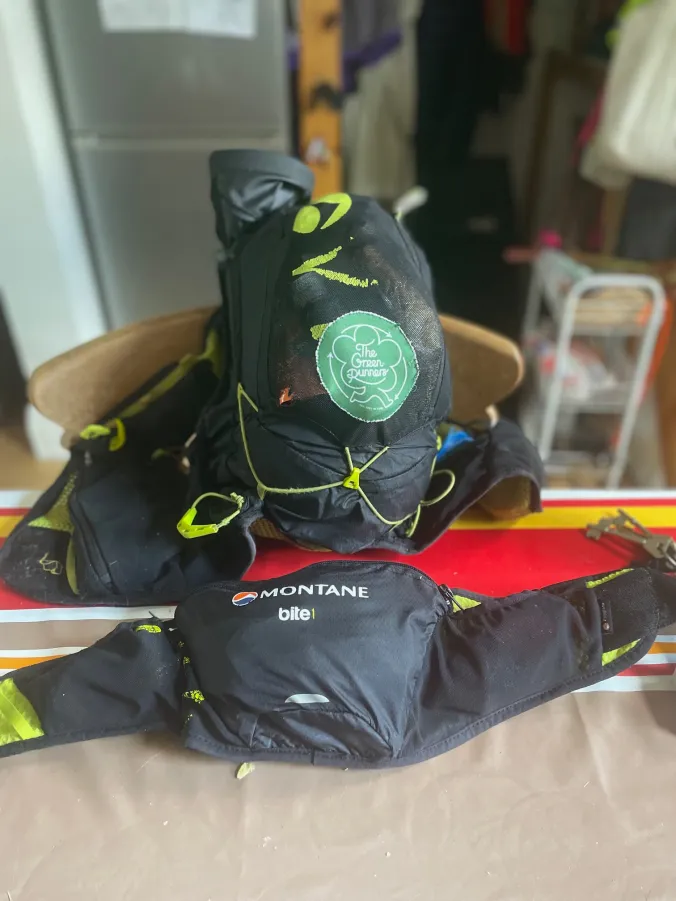
So I was definitely overloaded but on the other hand I saw at least two runners who had only a tiny bumbag to which my and Liz’s reaction was WTAF? That first mile up Pendle was memorable for three things: Liz first deciding that I was a character from the Hunger Games, the astonishingly blue sky patterned with mackerel clouds, and my god the humidity. I couldn’t see for sweat.
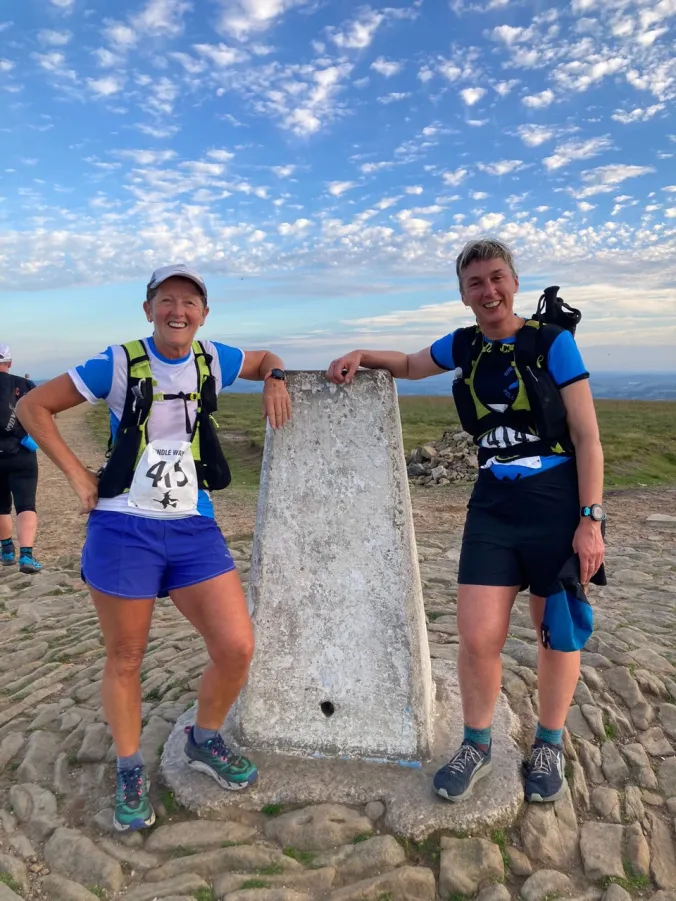
One mile down, 44 to go.
We hadn’t recced as there was little point for an overnight race. We were going to navigate by following people who seemed to know where they were going, looking out for fingerposts with witches on them, Liz’s GPX on her watch and my OS maps app on my phone.
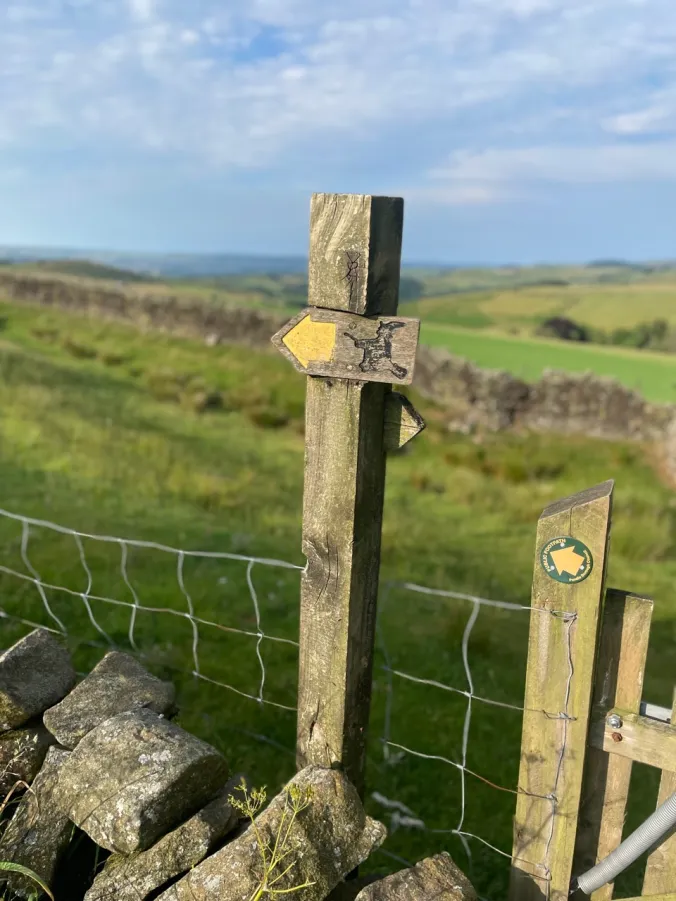
LIZ
As darkness fell the temperature did not seem to follow suit, it was a very warm and humid night. Running overnight was very different to torchlight club runs. The saying ‘still of the night’ was real. All we heard were animal sounds where we disturbed them and randomly a house party in a very remote location. The darkness lasted around 5 hours but it never seemed to get totally dark. We did at one point turn our torches off to view the night sky – I promptly tripped so just gave up on star gazing….
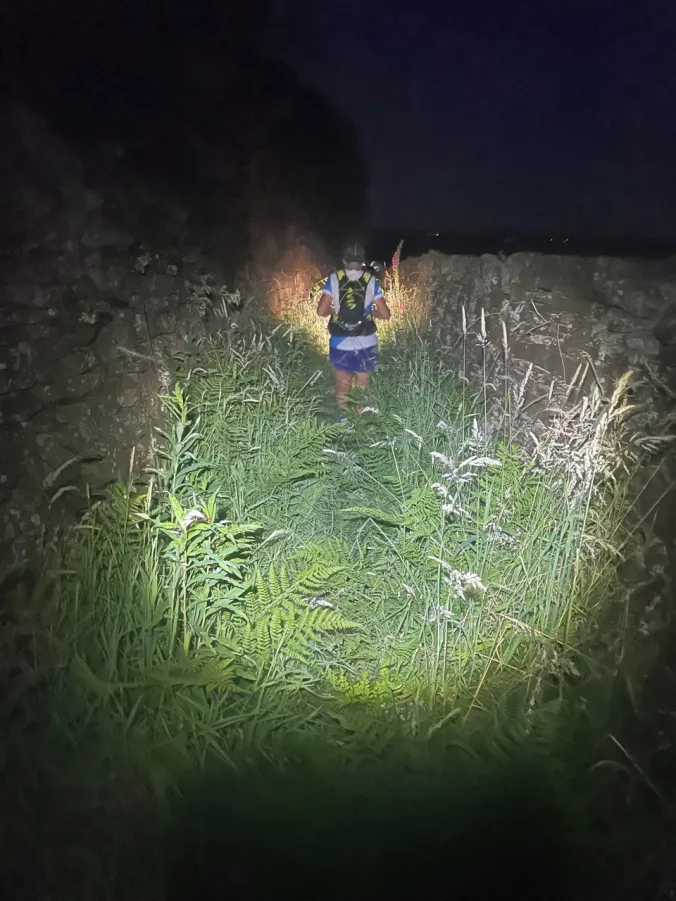
ROSE
Weirdly the thing I’d been most worried about was the easiest: running through the night when my body would usually have been fast asleep. I think I probably bored Liz by occasionally expressing my amazement that it felt so normal. The heat made wearing a buff uncomfortable, but other than that I really enjoyed the night. Liz kept turning to look at groups of headtorches behind us, and they were a comfort, particularly as later we wouldn’t see a soul for miles. She also got a reputation – with me – for having some sixth sense for fingerposts. “There! There’s a fingerpost!” Though perhaps that was just that she could see better, as I’d forgotten to put my racing contacts in. Her second spidey sense was for frogs. A couple of times she exclaimed and I thought something was wrong, but no it was just another lovely speckled frog on the trail, sitting there and not moving just because some hefty human was coming past. Physically I had been fine up until then (about six hours in), but then my knee started hurting. This happened on the Hebden 22 – extremely painful to go downhill, fine to go uphill – and I figured it was my ITB insertion point. I suppose it’s a fatigue-related weakness. So I had to stop to take drugs, fiddle with my pack and finally realise that what had been digging into my back for six hours was my first aid kit. Then I also had to find a quiet spot on a steep bracken slope to have an emergency toilet stop too. You try doing open defecation (about which I have written a book but that didn’t help much) while on a steep gradient in the dark and trying to leave no trace while not keeping your companion waiting too long. Exciting times at 2am.
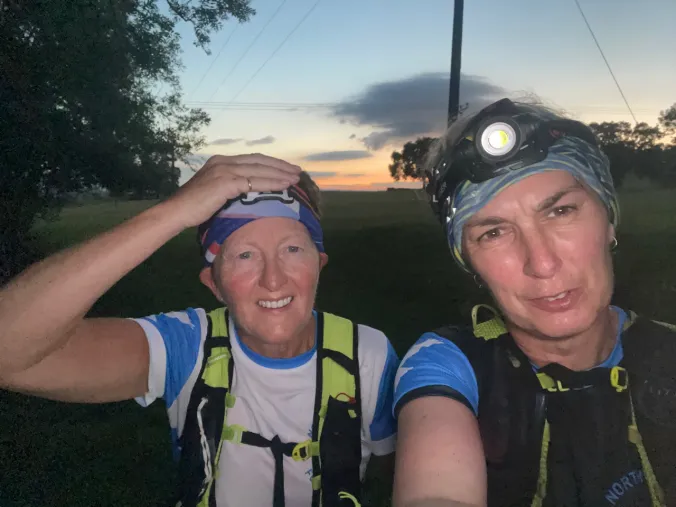
We didn’t hang out much with other runners but not because we didn’t want to. Maybe because it was night running? The couple we saw the most was a northern Irish woman and a man called Dave (I know his name because he stopped to take a picture of a bench which had been carved into the name DAVE). They didn’t run uphills or apparently the flat (ultrarunning technique?) so we would shuffle past at a jog, but as soon as we slowed to a walk, whoosh, they would overtake us walking and zoom off. They could walk so fast, it was seriously impressive. We took to calling them the Rocket Walkers (it was the middle of the night, we were knackered, we didn’t have a lot of creativity to hand).
LIZ
Rose noted the sunrise around 3.30am. I put it down to light pollution – I was wrong! Birds began singing, the flies appeared again, and at last there was a cool breeze. It was strange but nice to run through villages at such an early hour when everyone else seems to be sleeping. We encountered a group of young people going ‘somewhere’ with what looked like a festival tent at about 5am then a young man who looked as though he was on a walk of shame (he probably wasn’t but it’s fun thinking he was).
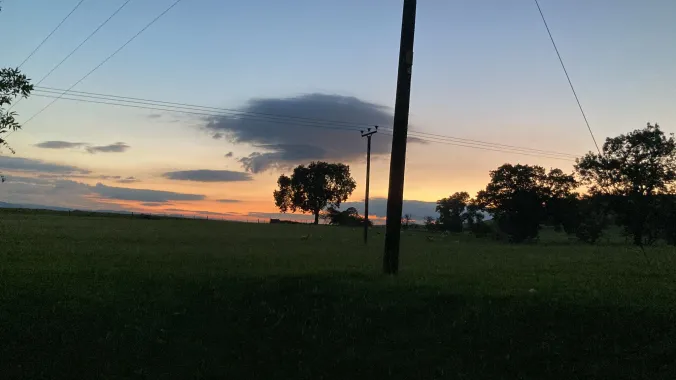
Not the city of Manchester
ROSE
Look over there, Liz, the light is coming. No, she said, there must be a city there. I thought, it must be a big city, but also that I could be wrong, it seemed early for dawn, even after I’d learned from the National Maritime Museum that there are three twilights (twilight is between light and dark and not just an evening thing): astronomical, nautical and civilian. This faint red was hazy, and finally I worked out that it was in the east and convinced Liz it was the sunrise. The gentleness with which the light came back was a delight. It was also a treat to take off our sweaty buffs and head-torches in the middle of yet another field. Liberated! We were both tired now, and on climbs – of which there seemed to be LOADS to the point where I would look ahead and say “oh bloody hell not another hill” and Liz would give me a positive thinking talking-to so I would say instead, “another hill! Cool!” – I gave Liz one of the poles. Even one pole helped significantly. I knew we were tired, because I’d stopped my every-30-minutes “EAT SOMETHING” instructions to Liz and to me.
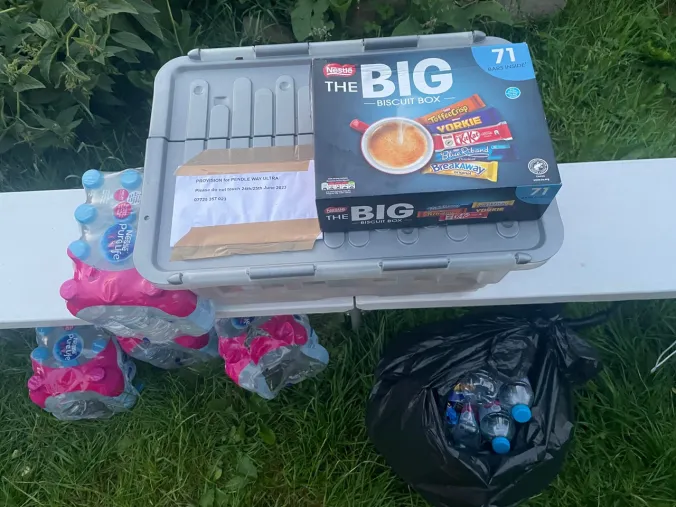
LIZ
We finished in 13 hr 50 m. We had had some navigation issues and ran out of water 90 minutes before the end. The Pendle Way is marked by a witch on fingerposts obviously. And the race organisers ensure that funds from the run are given back to maintaining the Way. The first four checkpoints provided food and drink: one had fairy lights (very pretty in the dark) and at the checkpoint in Laneshawbridge after Wycoller (operated by Roxanne, joint RO with her husband Jamie) there was a whole bloody bar. Rum and whisky! We didn’t partake. Too busy chugging Coke.
ROSE
Running out of water was not strictly our fault. It’s very hard to find people to staff checkpoints overnight, which meant that ideally there would have been water and food at Barnoldswick (9 miles from the finish) but there wasn’t. So the last provisions, in the form of a Tupperware box of goodies and bottles of water left on a bench with a sign asking people not to nick them, were in Earby, still 20 miles from the finish. We both filled our flasks in Earby, but we should have taken an extra bottle each. Probably the worst stretch of the route were the few miles of numbingly boring canal coming into Barnoldswick. Liz disliked the canal so much she stopped running in protest. Then it was up and over Weets and down into Barrowford to find a self-clip with the instructions “a cobbled lane and an iron gate.” We could have gone to find a newsagent at that point, things were starting to open, but we just desperately wanted to finish and we had just over three miles to go. I’d hoped we could do 4 miles an hour and finish in a total of about 11 hours. But I’d also thought the route was 42 miles because that’s what the GPX provided by the race organiser said. No. It was 45 and the 11 hour target receded pretty quickly thanks to navigation, night running, and niggles (mine).
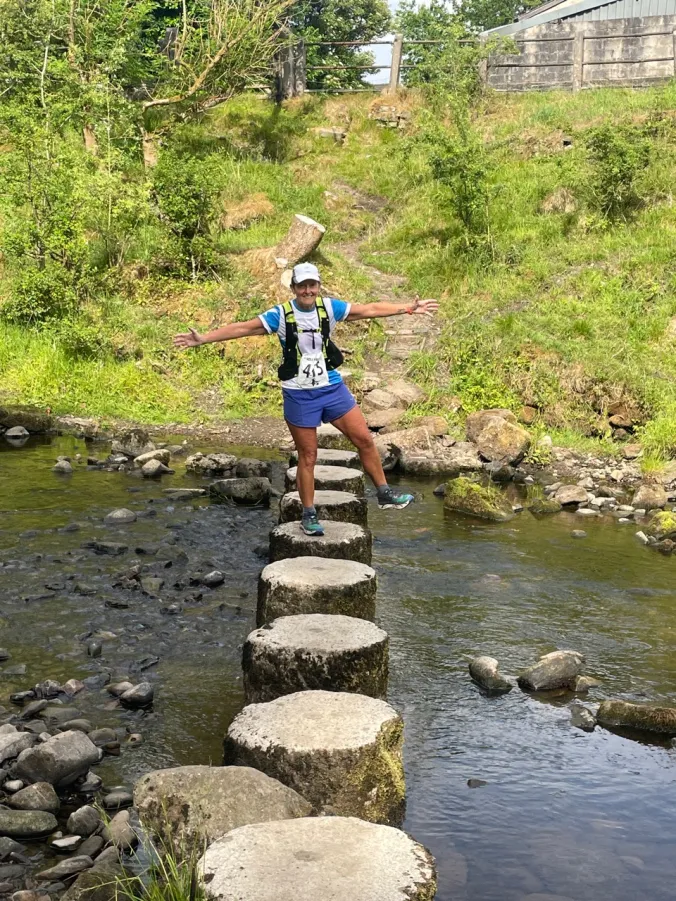
LIZ
I would recommend this run to anyone. It was an amazing and fun experience and given I was in the company of Katniss Everdeen so how could it not be fun? Katniss may well have converted me to the use of poles. Would I do it again? Hmmmmm given the next one is 5 years away we will have to see…. The daytime winter version is on every year.
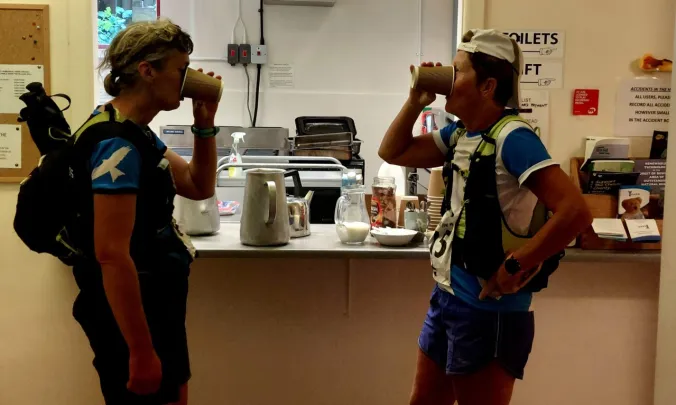
Never has a glass of orange squash tasted so good
ROSE
I’m so proud of myself for having done this, even if we did it more slowly than I’d hoped, and I was disconcerted to arrive at Barley to be told that we were the last. Though my disconcertedness had to wait because although Jamie, the RO, was offering us a lovely laser-cut wood coaster bearing of course another witch, we said YEAH BUT CAN WE HAVE SOME WATER RIGHT NOW. I can’t remember being as thirsty as I was for that last 90 minutes. At one point we were going through a field and I wondered if I chewed the grass whether I’d get some liquid. There is nothing as overwhelming as thirst and I am determined I will never experience it again if I can help it. Otherwise, it was a fantastic 13.50 hours, Liz was excellent company, as were the frogs. And the reason we were last is only 12 people did the 45-mile route, and plenty who had signed up for it dropped to the 30 instead which explains why we stopped seeing people behind us after Roxanne’s bar: that was the decision point. There were only 3 women in that 12 and we were two of them. (The other was the Rocket Walker.)
I didn’t eat all my food. I’m definitely not taking as much next time.
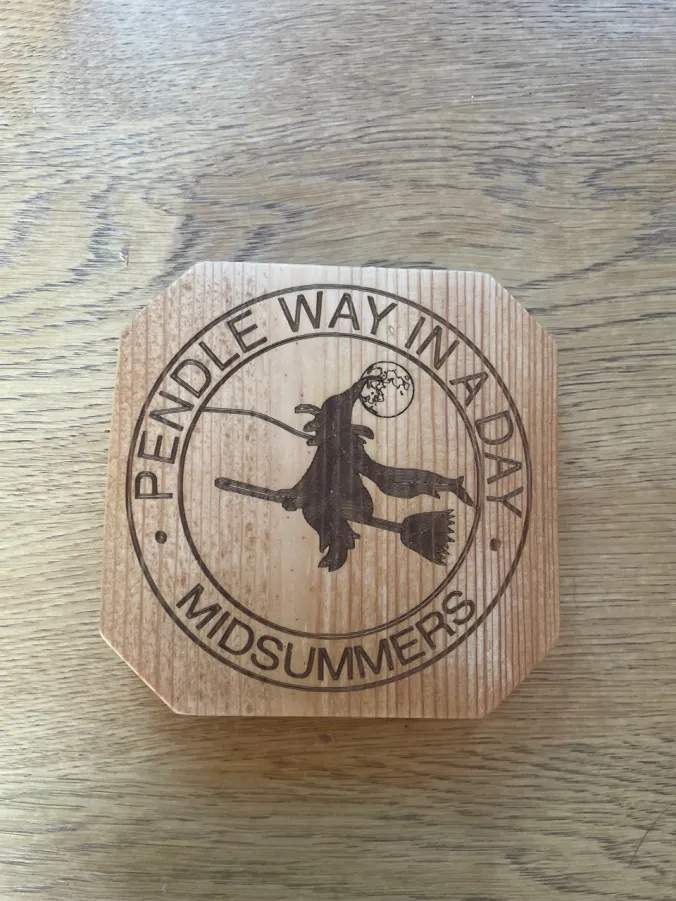
AFTERMATH
ROSE
I was not at all sleepy during the run and only yawned once. Adrenaline is a wonderful thing. As soon as we set off in the car, I couldn’t keep my eyes open and I’ve felt bone-weary since. So I’ve slept loads. The first night I tried spraying magnesium on my legs but the nettle stings and bramble scratches made that a very bad idea. Don’t do that unless you want to wake your neighbours with your yelps and screeches. The oddest thing is how little hunger I have had. My usual pattern is to do a long run, have no appetite for an hour or so then eat everything. This time has been different: the eating everything part has never materialised. Maybe because we ran through the night and that threw things out of whack, or perhaps because the distance and the time on feet triggered “lac-phe,” a metabolite that is related to exercise and suppresses appetite. Other than that, my chafing subsided, though I found a nasty abrasion from my bra strap that I hadn’t even noticed. When I took my shoes off in Barley car park they were greyish white and looked awful. But they have recovered nicely too. I suppose I’d better start running again.
LIZ
Like Rose I have felt fatigued and not wanted to eat. I managed to sleep for a couple of hours when I got home on Sunday. On Sunday night the magnesium spray took a real beating as my legs would not stop twitching. On Monday I enjoyed one of those nights where you feel you have not moved at all and slept really well. My trench foot had disappeared and my toes had almost forgiven me. Now in Spain for a few weeks, I am ready to go again, however the heat (current highs of 34 and lows of 23) has a different plan. I must remember to drink water and run very early in the day.
Thanks: Jamie and Roxanne and all the doughty volunteers who stayed up all night to feed and minister to us. And to Neil for cycling over to Barley at 5am so he could drive two very tired people home.
